The Seagate Ironwolf Pro 20TB HDD Review – NT Enterprise Edition
Seagate and their Ironwolf series of hard drives have fast become a mainstay of the NAS landscape in a relatively short time, considering their NAS HDD and eventual rebranding to Ironwolf in 2015/2016. In that time they have closed considerable ground on their biggest rival in this field, the WD Red series, and now although the brand first released Ironwolf Pro 20TB NAS Hard Drives back at the start of 2022, they are now in the process of revising a number of these drives and introducing a new higher durability STX0000NT001 series to join that existing the STX000NE001. These newer class of Prosumer/large-scale storage array NAS hard drives arrive with almost twice the workload rating, more than double the MTBF rating and still maintain the same high reported performance levels. All this said, why the sudden change? Perhaps facilitated by hardware shortages or due to the growing concerns of some users over larger capacities having the same workload rating of smaller capacities, leading to diminishing durability returns? Whatever the reason (more on that later), there is no denying that 20TB of storage in a single 3.5″ HDD casing is something to behold and today we are going to review this new massive drive from Seagate, benchmark it, test it with leading NAS brands Synology and QNAP, discuss the differences ith the existing Ironwolf Pro range and (hopefully) help you decide if it deserves your data? Let’s begin.
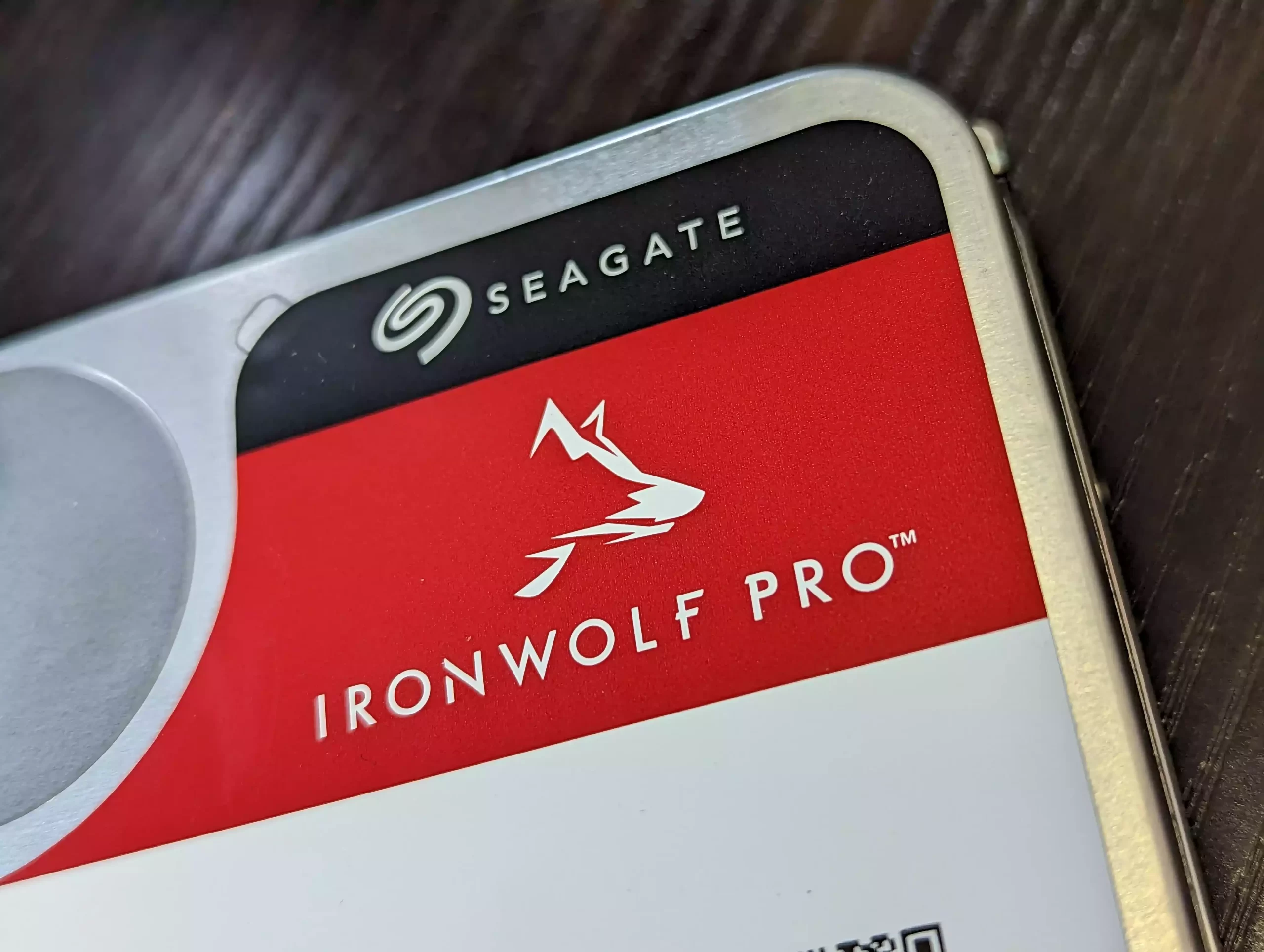
Seagate Ironwolf Pro 20TB Hard Drive Review – Quick Conclusion
Straight out the gate, the Seagate Ironwolf Pro 20TB HDD comfortably delivers on it’s promises of performance. This alongside full tested and confirmed compatibility with Synology and QNAP NAS devices means that you have a drive here that can turn any 4-Bay NAS into a 60TB RAID5 Storage colossus – let alone once you start thinking about rackmounts and hyperscale. The pricing at the time of writing is a little muddled (the result of having two SKUs/Model IDs floating around in the market and eTailers having to play catch up) but that should hopefully iron out over time. I particularly appreciate that the workload discussion surrounding ‘Pro’ Class drives at 300TB/yr vs rapid HDD capacity growth is being addressed here with a 550TB/yr version to rival that of ‘Ent’ class drives – whatever the reason/motivation. The value of the Ironwolf Health Management tool is going to be something of debate and the inclusion of 3yrs data recovery services is a nice extra that (with any luck) few will need to use – but having them included in a 20TB HDD that still manages to maintain a similar level of Price per TB vs the bulk of NAS HDDs in the Pro tier increases the value notably. As HDDs continue to increase in scale and Seagate (among other brands) continues to outline their plans to hit 50TB by the end of the decade, the Seagate Ironwolf Pro ST2000NT001 is another good example of an HDD that finds a sweet spot between price, durability and value. Just be aware that this is a drive designed for large-scale use and that means high operational noise and higher than typical power use than non-Pro and smaller cap drives!
Where to Buy a Product





![]()
![]()

VISIT RETAILER ➤






![]()
![]()

VISIT RETAILER ➤






![]()
![]()

VISIT RETAILER ➤






![]()
![]()

VISIT RETAILER ➤
What is the Difference Between the Seagate Ironwolf Pro ST2000NT001 NE Drive and Ironwolf Pro ST2000NT001 NT Hard Drive?
The difference between the previous/current generation of Seagate Ironwolf Pro HDDs and these newly released NT versions is largely based on their build and design being much close to that of the Seagate EXOS series, which results in higher sequential performance in the lower capacities, longer/higher durability rating and a larger scope of deployment. (Note – you can find out more on this in our article HERE or in our video HERE)
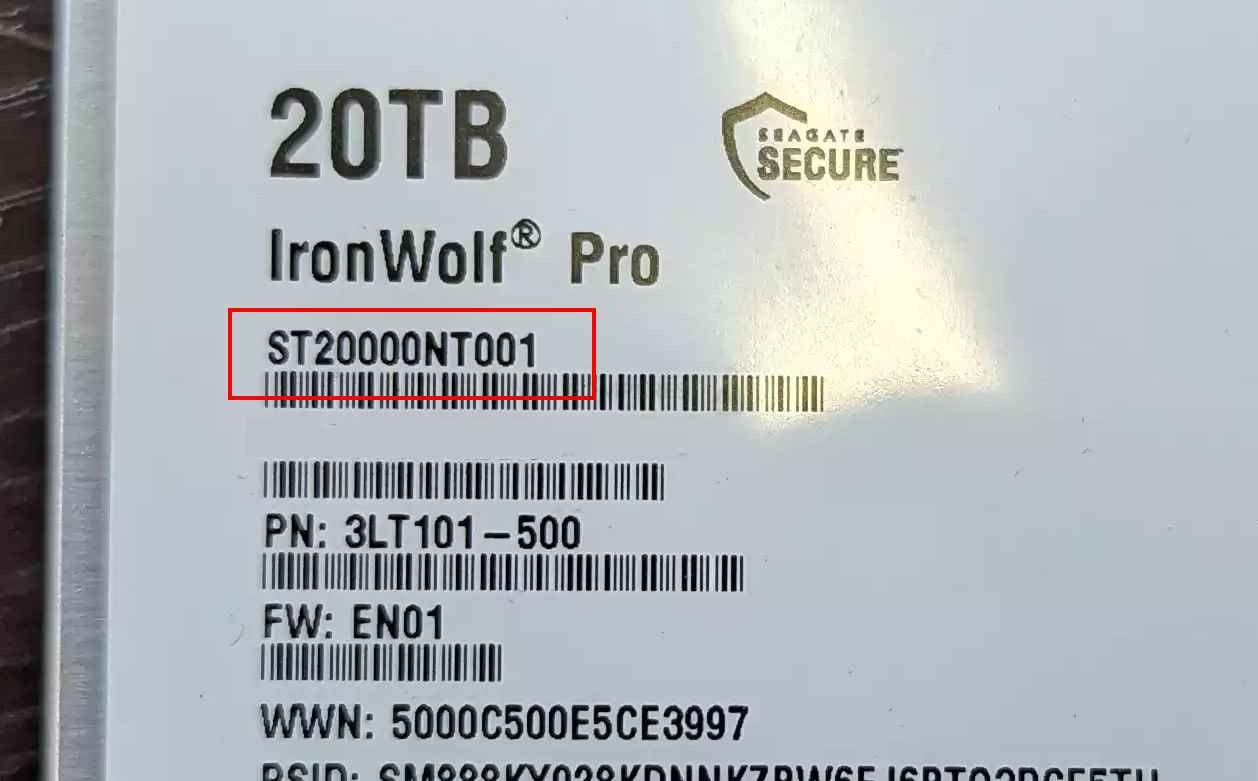
Main Key Differences Between Seagate Ironwolf Pro and the New NT Version
- Standard Ironwolf Pro drives can be used in upto 24 Bay enclosures, whereas these new NT drives are data center scale in their deployment and results in limitless enclosure volume support
- Standard Itonwolf dries have a 300TB annual workload, Ironwolf Pro can take 300TB a year and the new Seagate Ironwolf Pro NT series can reach take 550TB of writing per year
- Across the range of capacities of Seagate Ironwolf Pro and the new Ironwolf Pro NT versions, the new NT version is around 15-30MB/s faster on reported sequential performance (likely higher in typical ad-hoc use). This increase is minimal in the larger capacities though
- The Seagate Ironwolf NT series arrives with a reported 2.5 Miliion hours MTBF vs the 1-1.2 Million on standard Ironwolf Pro drives
Here is how the two versions of Seagate Ironwolf pro compare side by side on the rest of the specifications
| HDD Type | Seagate Ironwolf Pro v.2
|
Seagate Ironwolf Pro
|
| Price | £509 / $539 / €569 (01/02/23, ST20000NT001 version) | £449 / $429 / €449 (01/02/23, ST20000NE001 version, Currently on offer in numerous locations) |
| Available Capacity | 2TB-20TB | 2TB-20TB |
| Model ID Standard (X=capacity | STx000NT001 | STx0000NE000 |
| Interface | SATA | SATA |
| Drive Bays Supported | Unlimited | 8-24-Bays |
| Magnetic Recording | CMR | CMR |
| Workload Rate Limit (WRL) | 550TB per Year | 300TB per Year |
| Rotational Vibration (RV) Sensors | Yes | Yes |
| On-board Cache | 256MB | 256MB |
| Mean Time Between Failures (MTBF, hours) | 2.5Million | 1Million |
| Sector Size (Bytes per Logical Sector) | 512E | 512E |
| Rescue Data Recovery Services(years) | 3yrs | 3yrs |
| Spindle Speed (RPM) | 7200 | 7200 |
| Max. Sustained Transfer Rate OD Seq Read (MB/s) | 285MB/s (20TB)
285MB/s (18TB) 270MB/s (16TB) 270MB/s (14TB) 270MB/s (12TB) 263MB/s (10TB) 255MB/s (8TB) 250MB/s (6TB) |
285MB/s (20TB)
260MB/s (18TB) 255MB/s (16TB) 255MB/s (14TB) 240MB/s (12TB) 240MB/s (10TB) 240MB/s (8TB) 220MB/s (6TB) |
| Rotational Vibration @ 10-1500 Hz (rad/s) | 12.5 | 12.5 |
| Operating Temperature (ambient, min °C) | 0 | 0 |
| Operating Temperature (drive reported, max °C) | 65 | 65 |
| Nonoperating Temperature (ambient, min °C) | -40 | -40 |
| Nonoperating Temperature (ambient, max °C) | 70 | 70 |
| Vibration, Nonoperating: 10Hz to 500Hz (Grms) | 2.27 | 2.27 |
| Acoustics, Idle (typical, measured in Idle 1 state) (dBA) | 20 | 20 |
| Acoustics, Seek (typical) (dBA) | 26 | 26 |
| Shock, Operating 2ms (Read/Write) (Gs) | 40/40Gs | 40/40Gs |
| Shock, Nonoperating, 1ms and 2ms (Gs) | 200 | 200 |
So, as you can see, both are available in between 2TB and 20TB at the time of writing, but it is in just a handful of specifications (though crucial to larger scale RAID/configurations) that major differences between the STXX00NE001 and STXX00NT001 can be observed.
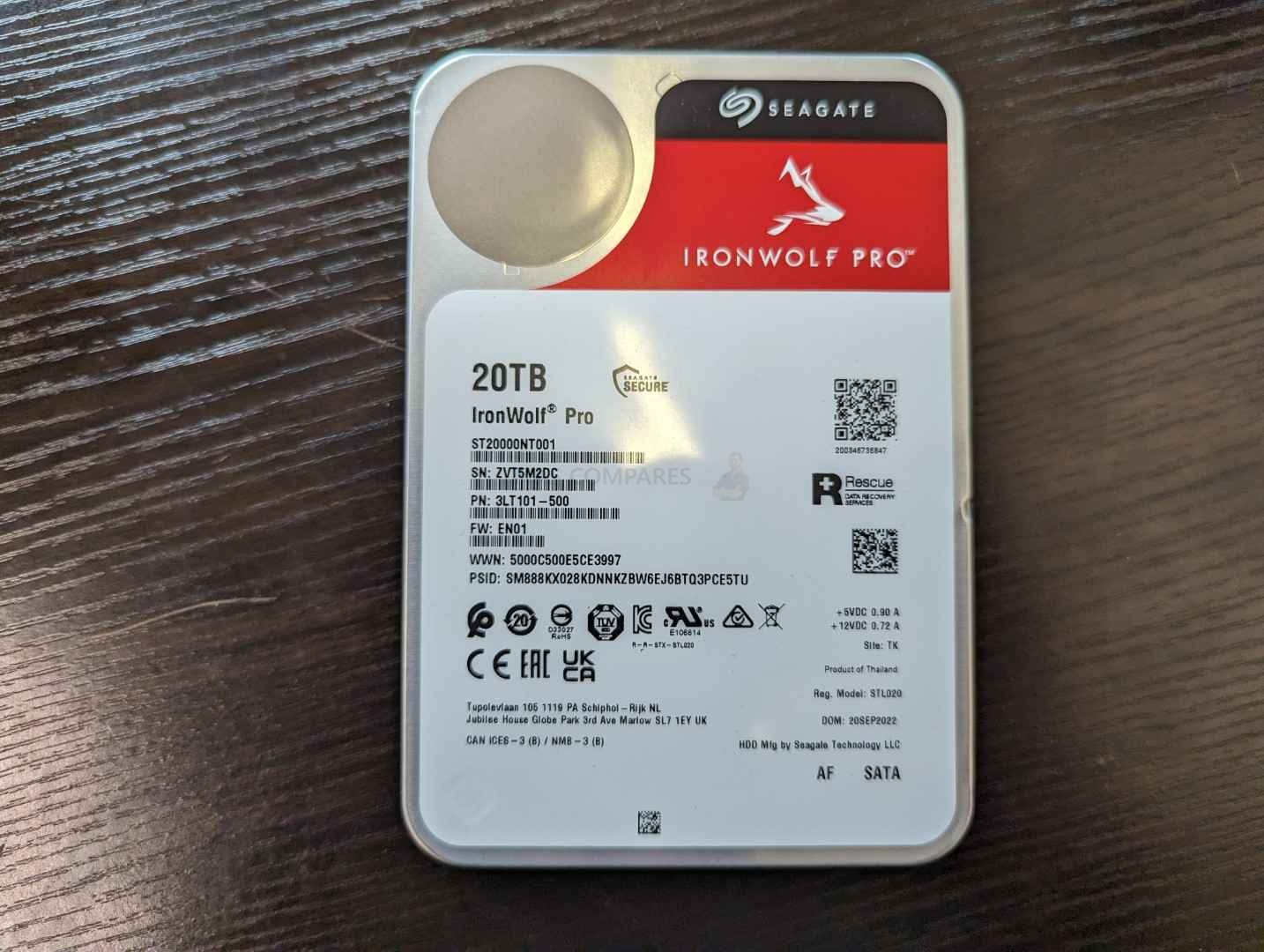
Seagate Ironwolf Pro 20TB Hard Drive Review – Design
The design of the Seagate Ironwolf Pro 20TB HDD remains largely unchanged in appearance compared with the most recent high-capacity releases. The 3.5″ casing is helium sealed and the new NT class of drives arrive with a change in the labelling to differentiate them from the NE Ironwolf Pro series. Perhaps this differentiation is the separate them for use in 24+ Bay servers (given the oddly open-ended ‘unlimited bay’ support on the spec sheets vs the ‘upto 24-Bays of the Ironwolf Pro till now). Typically NAS/SAN system that feature 24x and higher storage bays would have been urged to opt for the EXOS series (available in both SAS and SATA). Perhaps this is a means to open up and bracket the Hyper-Scale and Data Center tier up, as more and more medium-large business setup single/paired Rackmounts outside of the large-sclae cabinet settings of the past? It’s hard to say, as otherwise, what problem is a newer and more durable Ironwolf Pro drive solving?
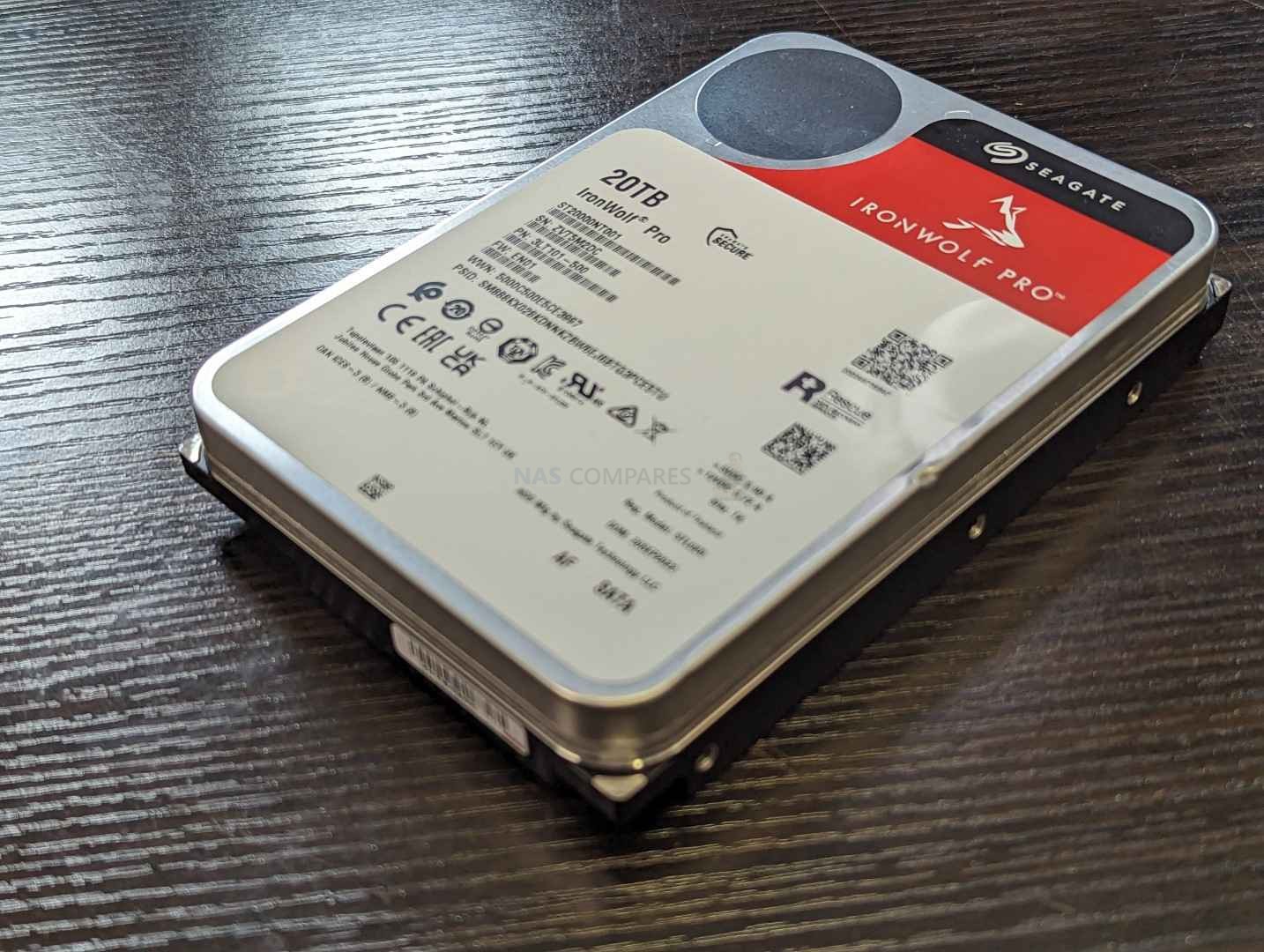
One argument might be the growing question of workload ratings on HDDs vs Growing Capacities and how they are starting to result in reduced margins of durability. The general rule of thumb when it has come to Hard drives for 24×7 server deployment is:
- Standard Class Server Drives (so, upto 8 Bays of storage, small-medium Business deployment) is 180TB workload a year over the 3yr warranty
- Large Scale Server Drives (above 8 Bays and upto 24 Bays for Higher-end business and large-scale deployment) at 300TB workload per year over the 5yr Warranty
- Enterprise/Hyperscale Server Drives (i.e Data Center, with theoretically limitless Bay numbers, factoring expansions and growth) at 550TB workload per year over the 5yr Warranty
Now the Seagate Ironwolf Pro 20TB is branded as a ‘Pro’ class drive (the middle one, above), however it arrives with a 550TB Workload rating, putting it well into the Enterprise bracket and treading on the toes of Seagates EXOS series – though lacking the SAS and Encryption options of EXOS options. However, the general rules of 180/300/550TB respective workloads on each tier begin to fall down a little when you factor that a 1TB drive that has a 300TB workload at 210MB/s performance and a 20TB that is also at 300TB workload annually, but 285MB/s max transfer will not only hit that workload limit quicker – but there is also the question of how this translates over time vs the available storage space and writes over time! Therefore the newer gen Seagate Ironwolf Pro ST2000NT001 Hard Drive arriving with 550TB/yr (alongside NT versions of many of the other lower capacities) does elevate this point somewhat for those users in between the Large Scale and Hyperscale/data center.
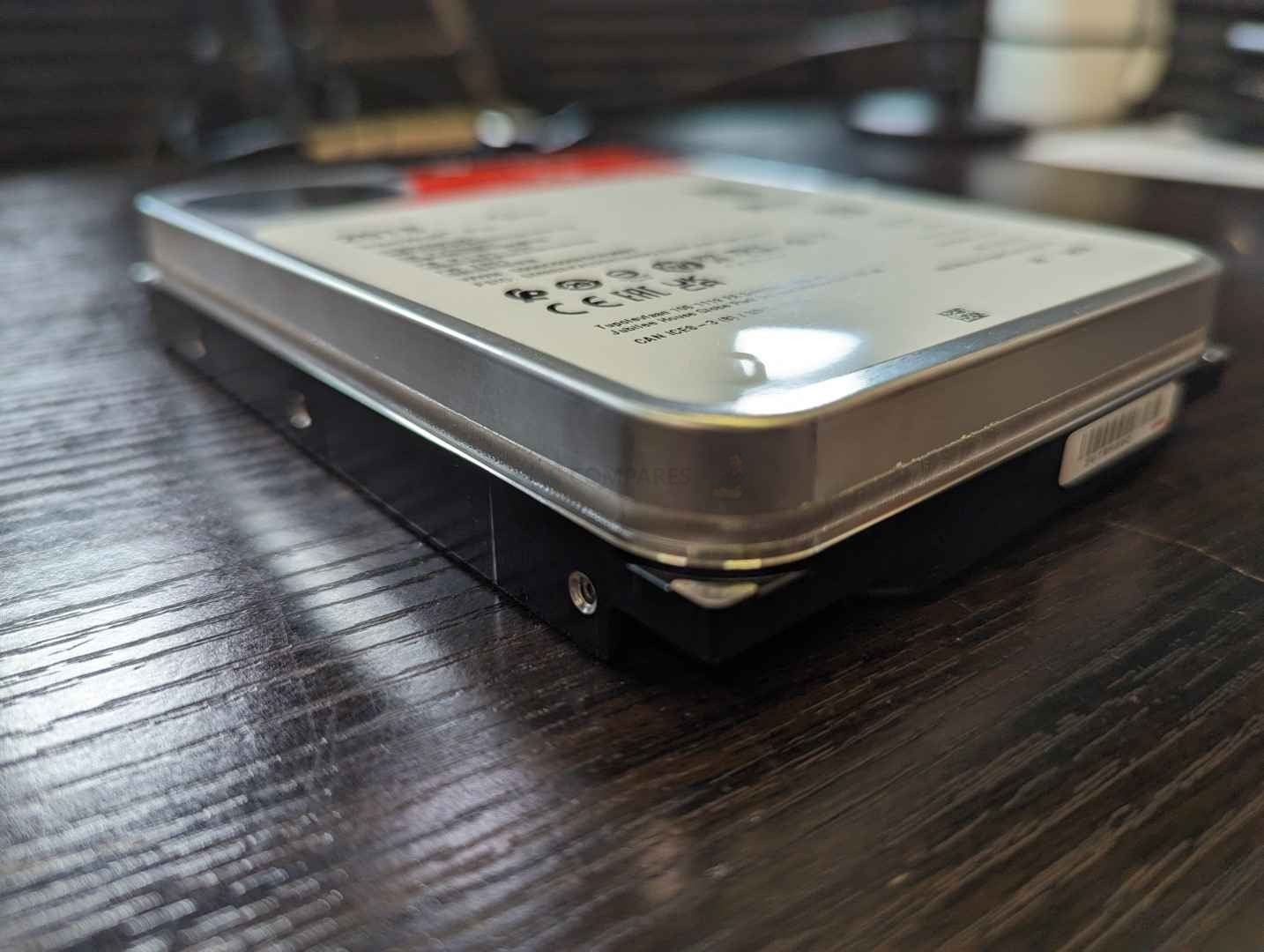
The 20TB in the ST2000NT001 is spread over 10 platters of 2TB each, made possible via the drive being helium sealed. This reduces potential internal drag and friction between platters, maintains the balance and allows much thinner platters to be used. Spinning at 7200RPM, the platters feature dual-plane balancing (known as AgileArray) also time-limited error recovery (TLER), which ensures the drive reading head isn’t delayed in intermittent read errors and can restart quickly to increase access when needed.
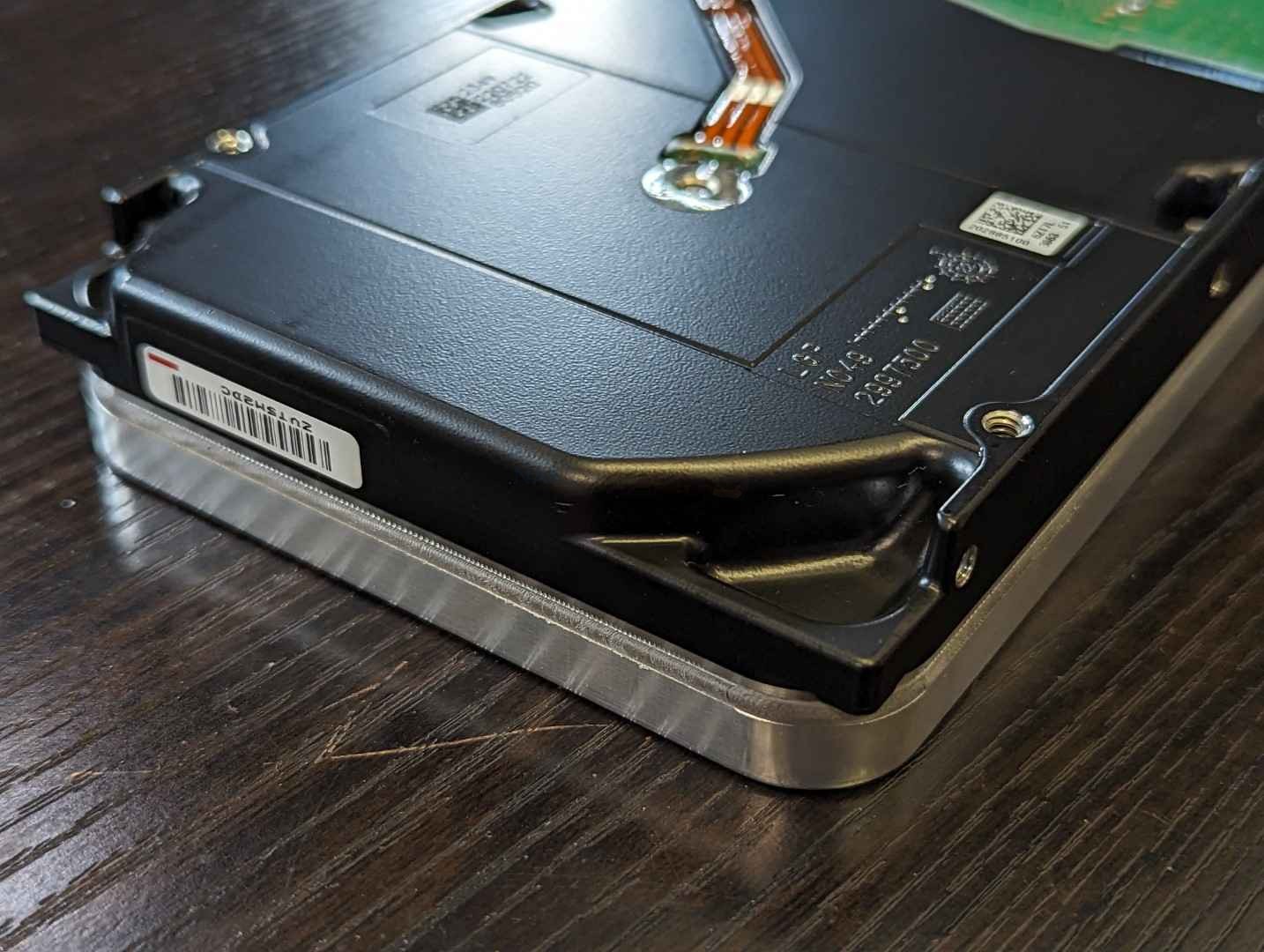
The 10 platters spinning at 7200RPM are also accompanied by 256MB of caching on board, which really surprised me, giving most of Seagate’s competitors have hit the 512MB cache level at this capacity tier. Having half the chance of its rivals does not seem to diminish both the performance or the sustained performance either.
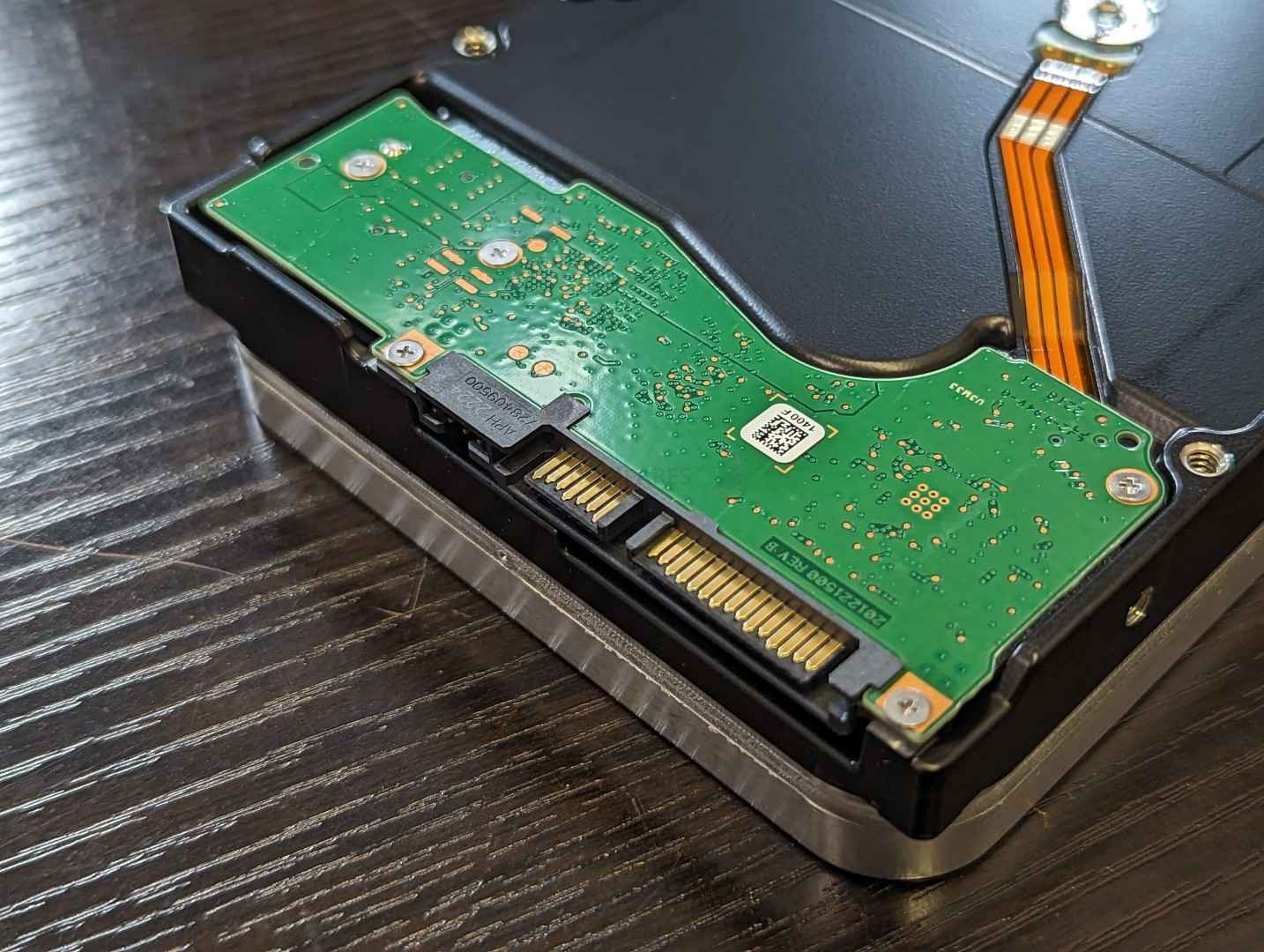
As mentioned, the Seagate Ironwolf Pro HDD series only arrives in SATA. Although I can understand that Segaate does not want to overlap TOO much with their EXOS range that they already have done, there are an increasing number of SAS NAS solutions arriving on the market (with both Synology and QNAP both increasing their range of solutions in this direction noticeably for their 2022/2023 generations). Yes, users could just go for a suitable SAS EXOS option, but then they lose out on the Rescue Data Recovery services and Ironwolf Health management on the drive.
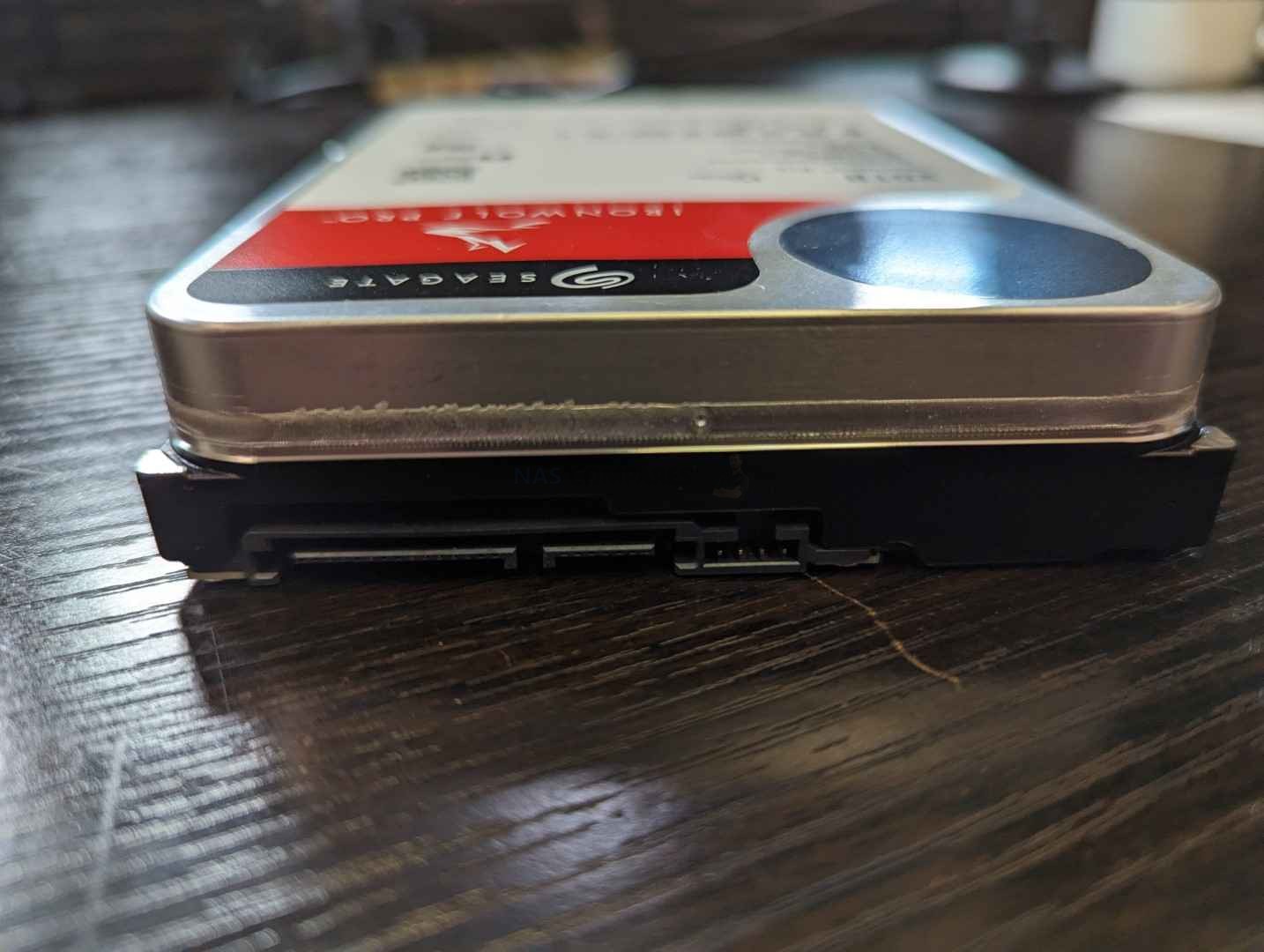
Overall, any improvements or changes in the build/construction of the Seagate Ironwolf Pro 20TB ST2000NT001 HDD over the rest of the range and/or the previous NE version are all internal. We have to take Seagate at their word on the effective doubling of the durability rating, but given their pedigree in the EXOS enterprise series, I have little doubt in this. Although the Ironwolf Pro 20TB is not the only NAS drive in the market right now that is breaking the 20 Terabyte level, it does arrive with a couple of things that many others don’t that we should cover – the included Data Recovery services and the Ironwolf Health Management tool for NAS.
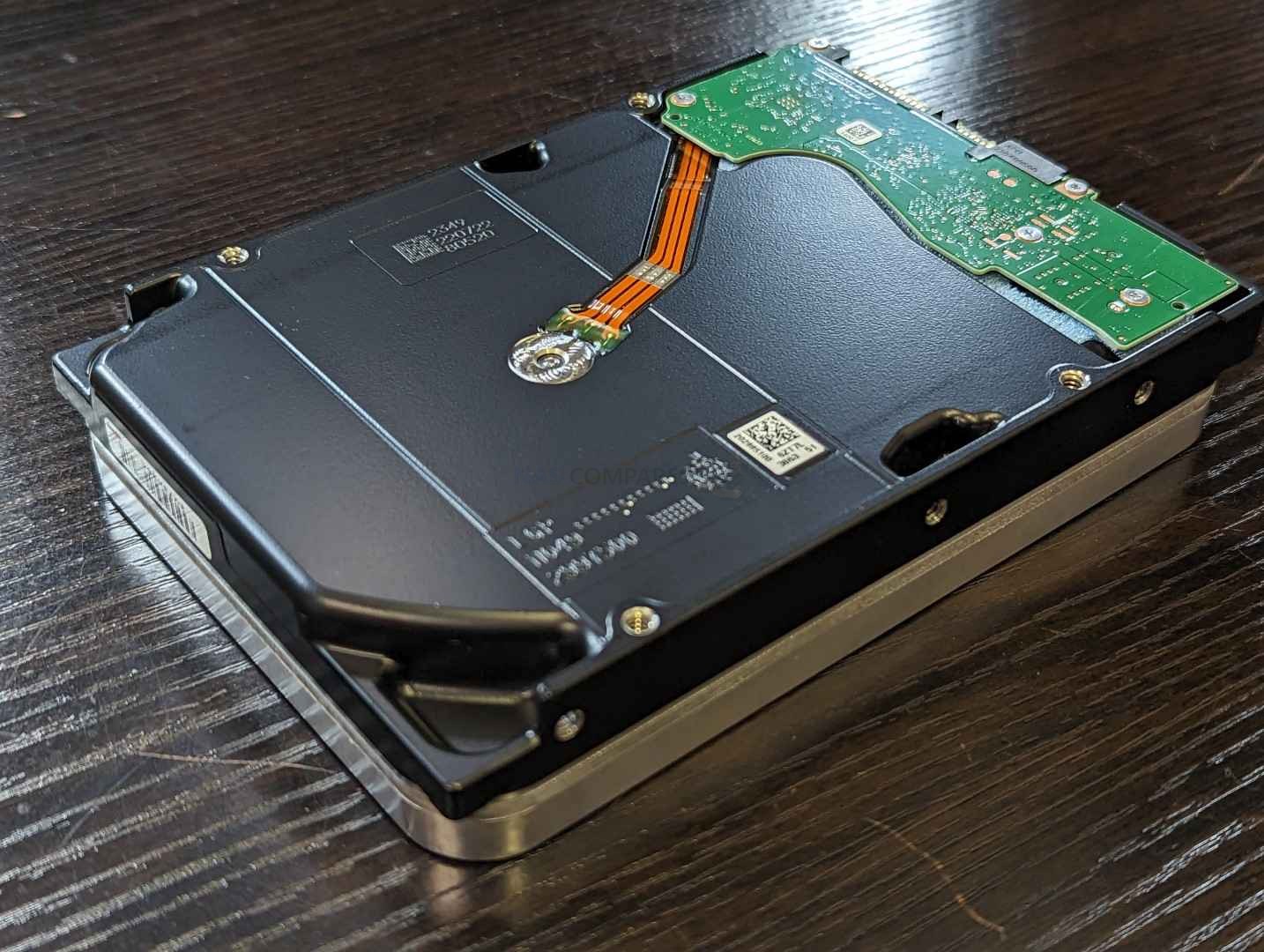
Is Seagate Ironwolf Health Management and Rescue Recovery Services Worth Caring About?
For those that are not aware, the Seagate Rescue+ package is a data recovery service that is included with your Ironwolf and Ironwolf Pro drives that, alongside your 3/5-year warranty, includes an additional 3 years of data recovery services. What that means is that if your drive fails through no fault of your own within reason (so, no, not smashing it with a hammer), you can send the drive off to the Seagate recovery labs and they will try to get that data back. From accidental deletion, all the way through to mechanical and forensic level recovery, this is an impressive inclusion! You should still factor other safety nets in your architecture (backups, UPS, RAID, etc) but given the cost of data recovery services (costing anything from hundreds to thousands of pounds), this is a very, VERY useful inclusion when you need it. This plus an already normally lower price point than Pro series drives in the WD Red series means that the Seagate Ironwolf hard drives still manage to be the better value choice for alot of users, especially when including the Rescue recovery included. They are also the only 3rd party NAS hard drive brand that has a tool to monitor drive health available on practically ALL the NAS software GUIs in the market, in Seagate Ironwolf Health Management. Here is part one of a two-part video series on the NASComapres YouTube channel were we showed the Seagate Rescue Recovery service (arguably, in a very extreme fashion!):
You can find out more on the Rescue service and its Pros/Cons in the video below. Otherwise there is another video detailing a guide on what to expect from data recovery costs/fees etc in a video from 2021:
Seagate Ironwolf Pro 20TB Hard Drive Review – Testing
Testing the Seagate Ironwolf Pro 20TB is going to be performed across multiple methods, but still rather unconventional. This drive is designed for deployment in large # Bay servers, but although I have several NAS in the studio that could accommodate this frequency of drives, I do not have sufficient Seagate Ironwolf Pro 20TB units. Therefore the testing I have conducted are all examples of single-drive performance. These will include several PC testing sessions using popular and recommended storage testing applications and two NAS tests involving Synology and QNAP.
- Windows 10 Pro Desktop System
- Intel i5 11400 Rocket Lake – 6-Core 2.6/4.4Ghz
- 16GB DDR4 2666MHz Memory
- Intel B560M mATX Motherboard
- OS Storage, Seagate Firecuda 120 SSD
- Test Hard Drive connected to a Sabrent USB 3.2 Gen 2 10Gb/s external dock
- Synology test was conducted on a DS923+ NAS using the system’s own benchmarking tool
- QNAP test was conducted on a TS-464 NAS using the system’s own benchmarking tool
These last tests are important as not only is the Seagate Ironwolf Pro 20TB HDD designed for NAS use, but also at the time of writing neither brand lists this hard drive as compatible. There is more to this though that I will touch on later.
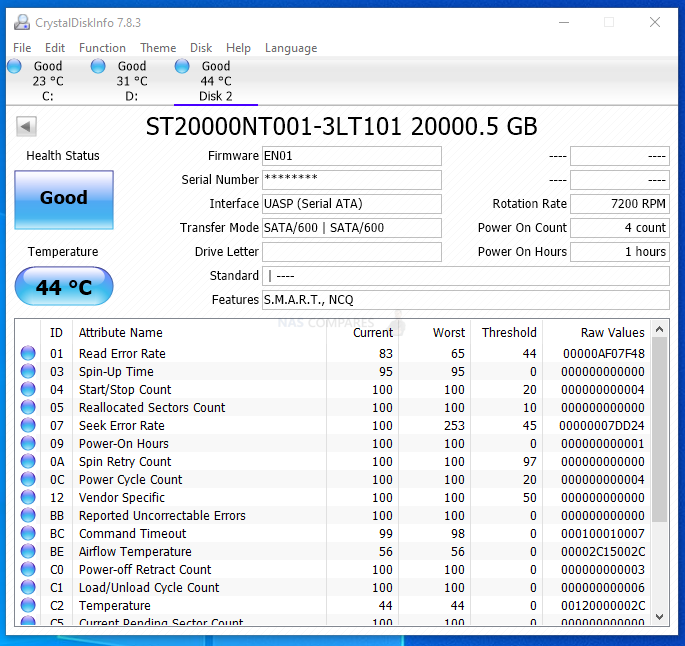
The first test involved using CrystalDisk. I performed tests on 64MB, 256MB, 1GB and 4GB test files, as well as mixed 70/30% R/W. The results were consistent and largely lived up to Seagate’s claims here.
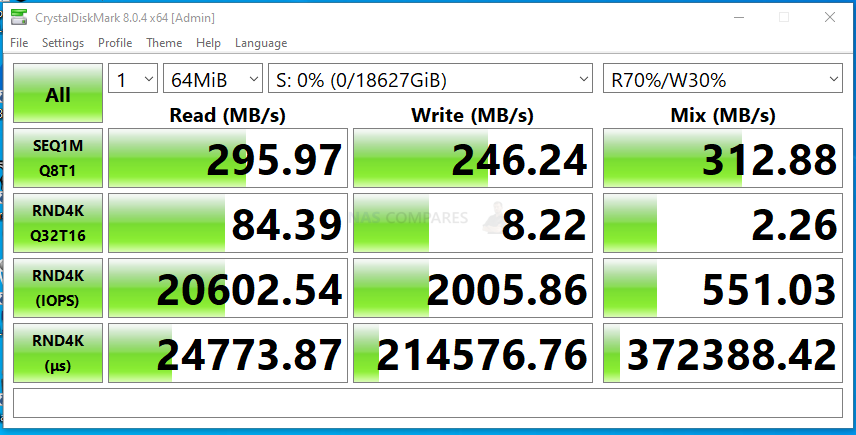 |
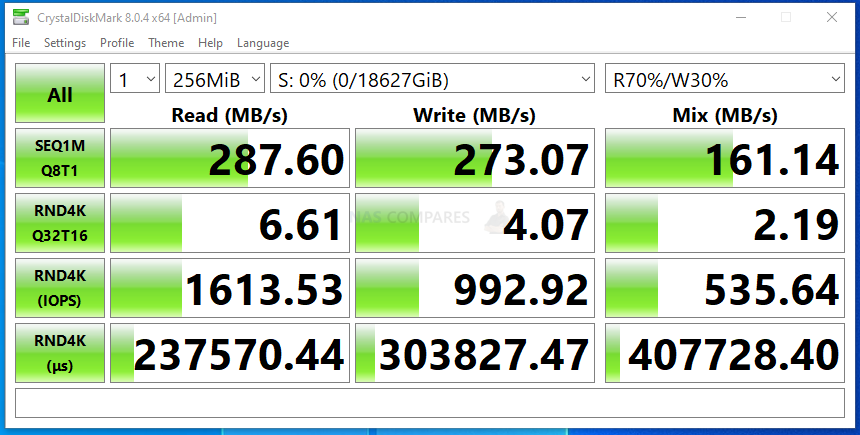 |
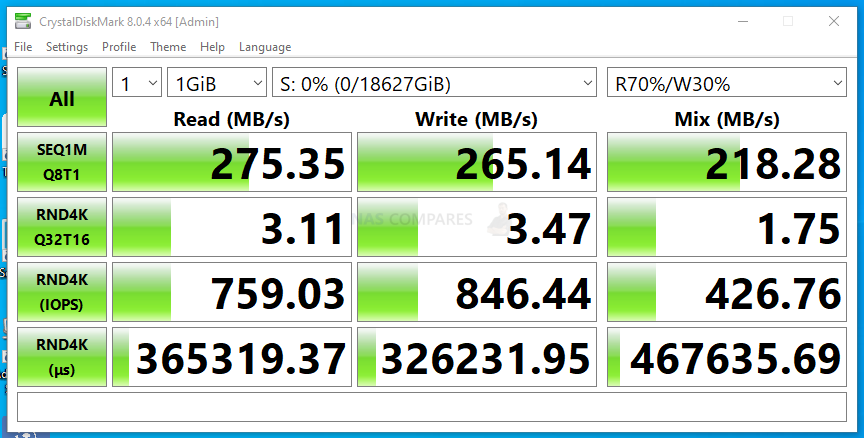 |
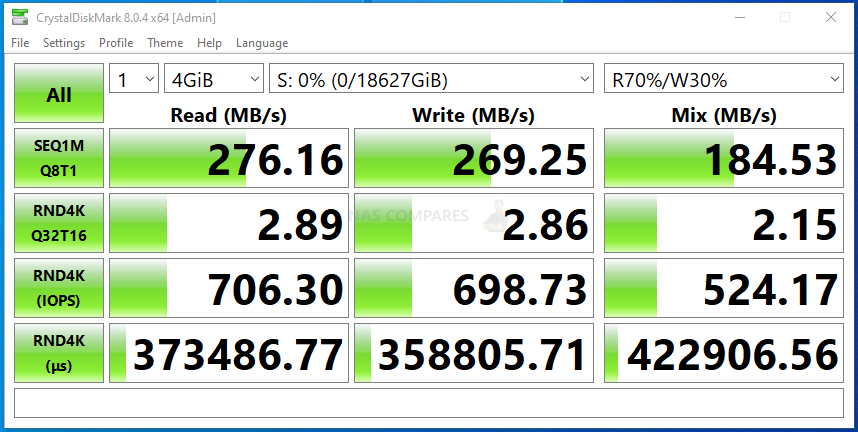 |
This test used AJA and was a 512MB, 1GB and 4GB Test of a 5K Test file.
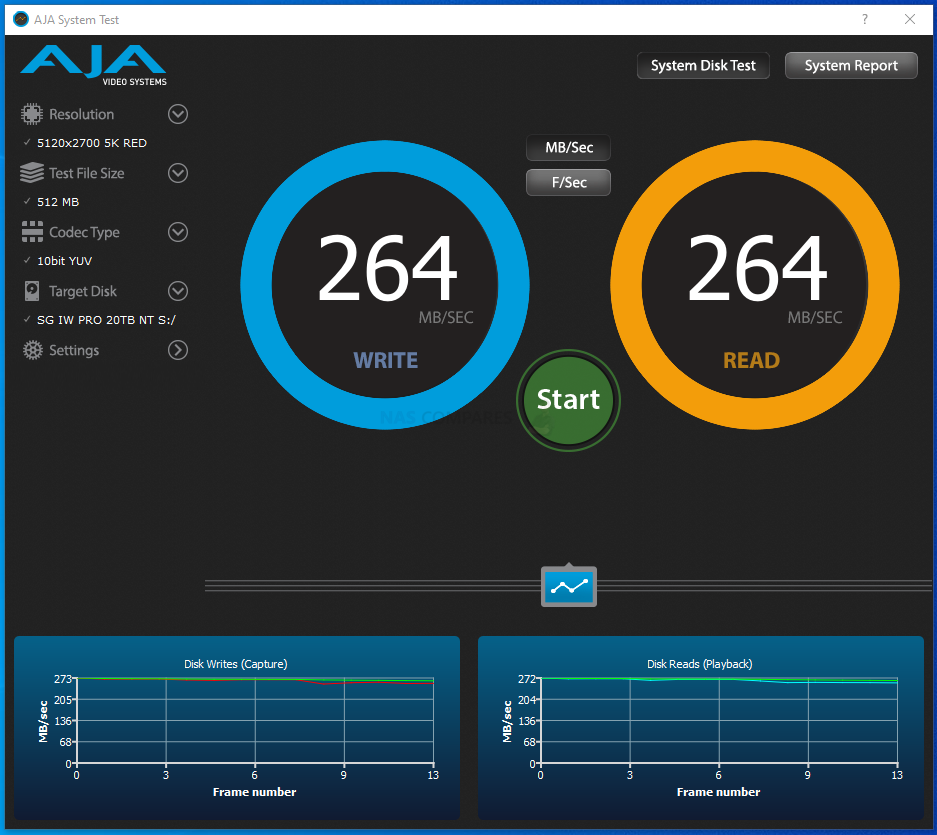
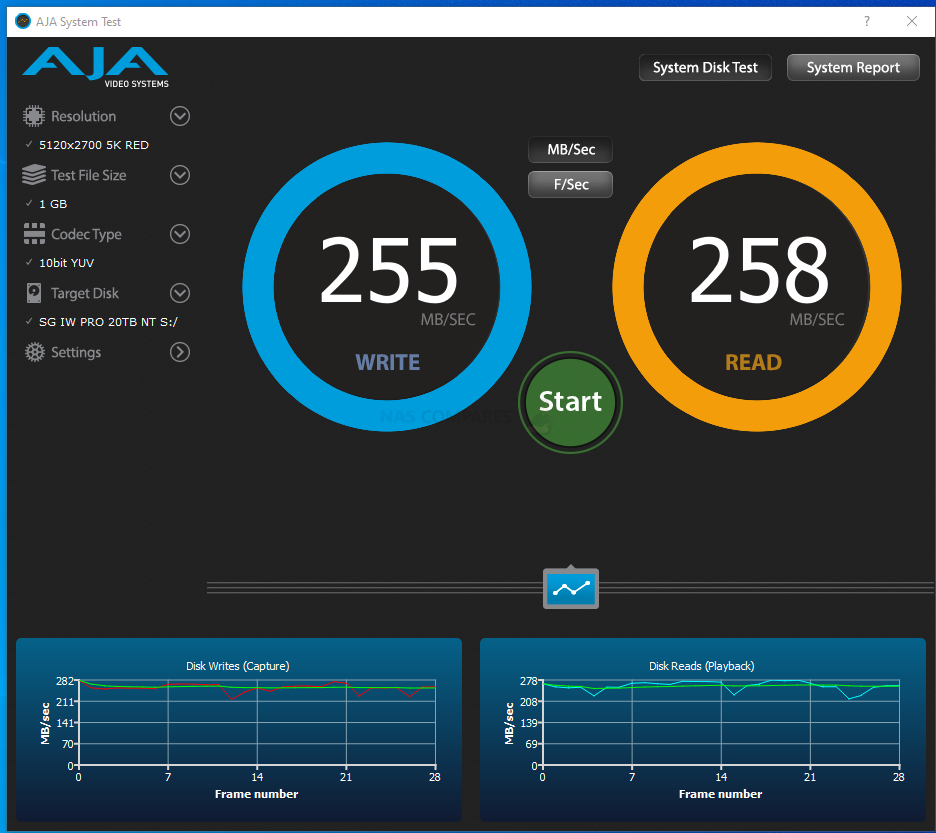
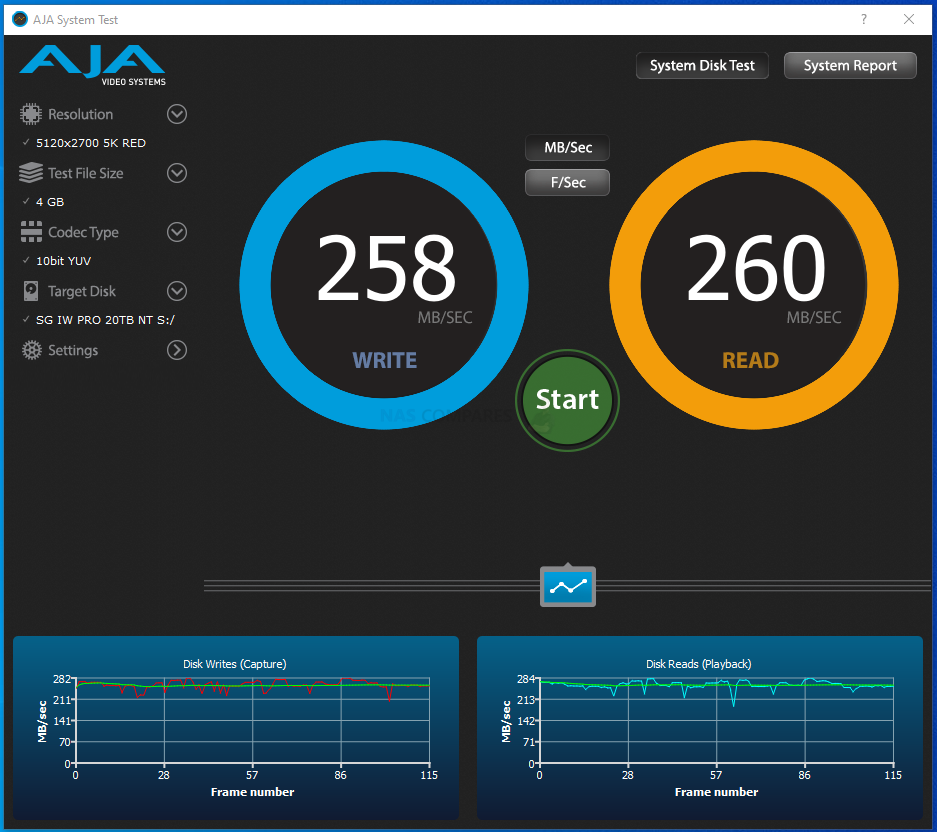
The next test used ATTO disk benchmark and this one used a 64MB, 256MB and 1GB test file in the same windows PC test environment. However, I also included the IOPS. The random 4K operations of a hard drive will typically be hugely dwarfed by those of SSDs, but enterprise HDDs and pro series drives still tend to rate noticeably higher than domestic HDD and standard-class NAS HDDs on this score.
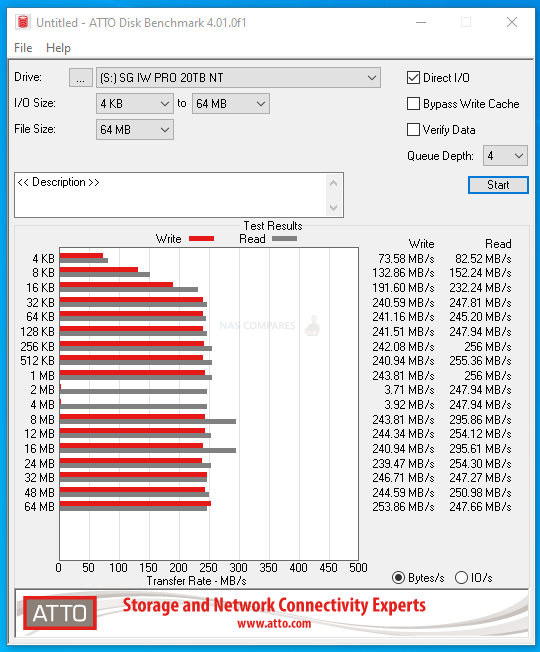 |
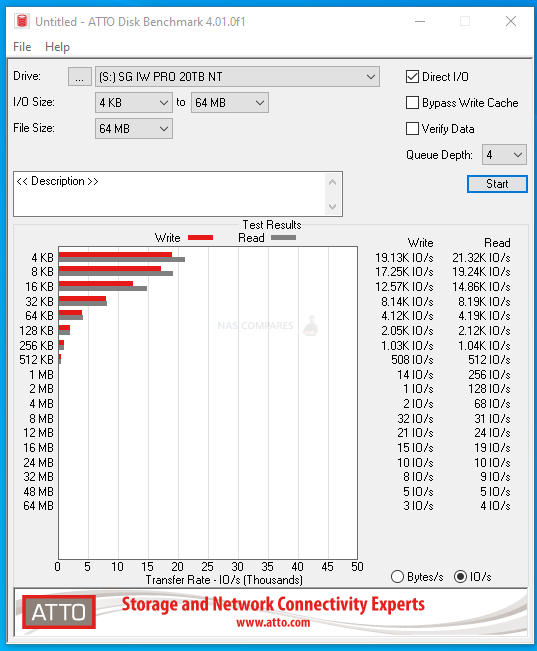 |
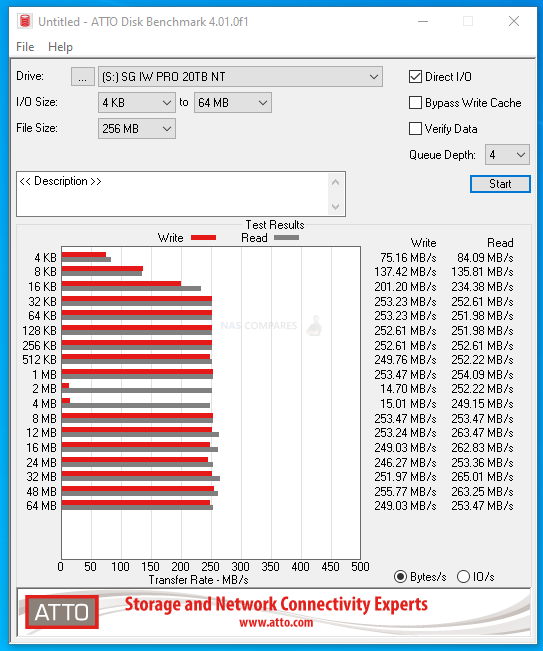 |
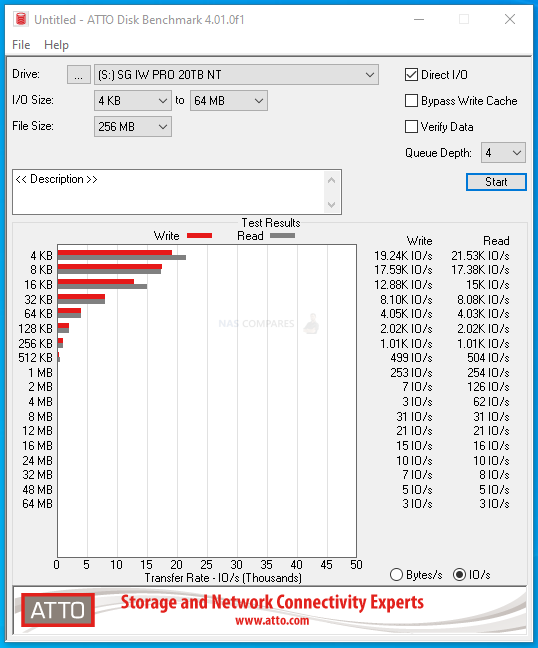 |
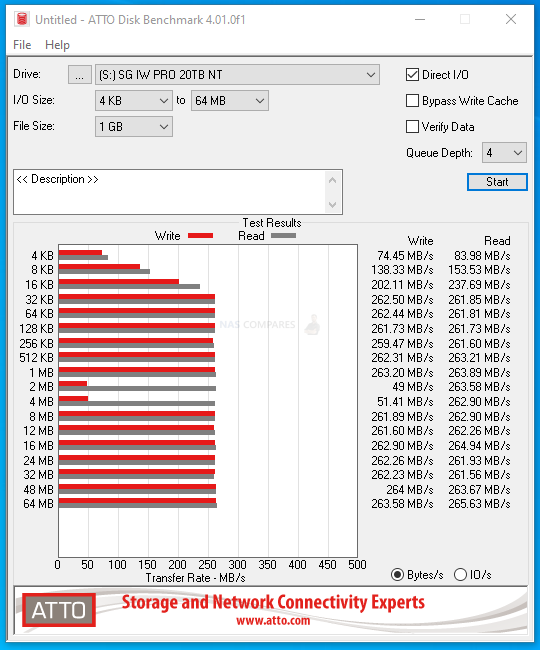 |
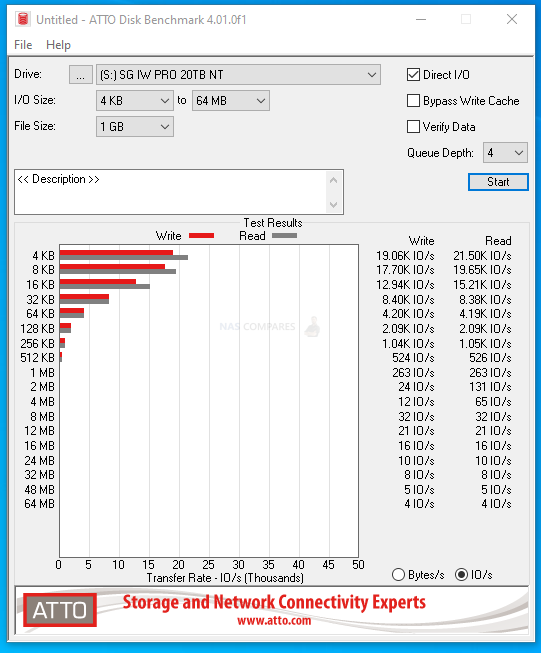 |
In order to conduct a windows performance test, I copied 22.8GB of mixed files (2,310x) over to the drive as a separate disk. The result was consistent performance and the transfer, averaging at 174MB/s on the windows transfer overall and peaking at 239MB/s. Although this is lower than the transfer rates stated by Seagate and in the synthetic tests above, this is perfectly understandable when dealing with this high volume of small/differing date, compared with the largely Sequential Data tests stated elsewhere.
2,310 Files, 22.8GB Windows Transfer – 02:44
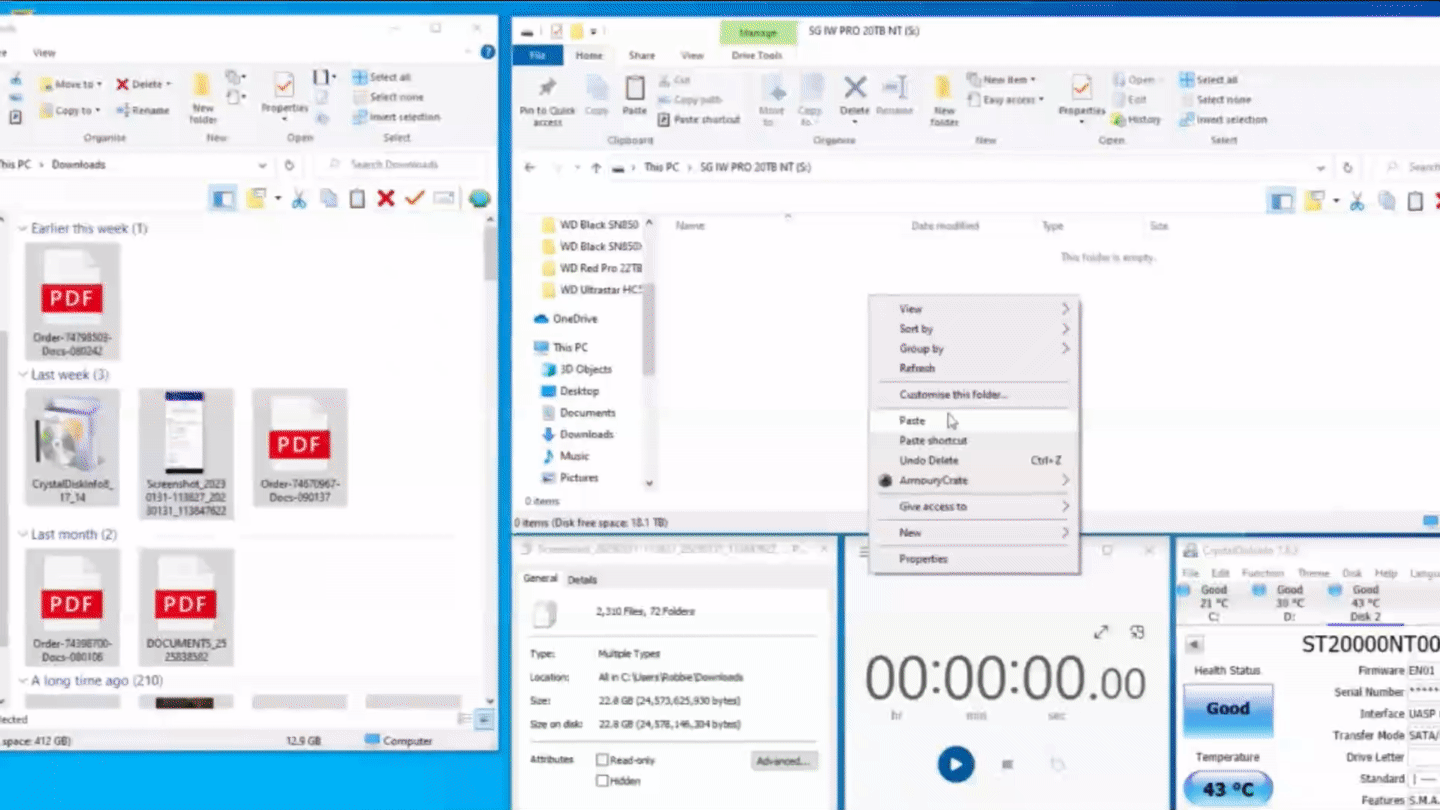
Synology & QNAP NAS Testing with the Seagate Ironwolf Pro 20TB Hard Drive
Now, before I move on to the NAS testing. It is worth highlighting a couple of important factors with regard to the Seagate Ironwolf Pro 20TB and the support available from each NAS brand I am focusing on for the testing. Now, Synology is the ONLY NAS brand in the market that also has its own first-party HDDs available to users too. These are Originally Toshiba Enterprise-grade produced hard disks that have had a Synology-specific firmware applied to them. Now, why is this relevant? Well, because some larger-scale Synology products in 2021 onwards do not list other 3rd Party HDDs as compatible. Even then, if you look up some of the older 2020 released NAS drives currently in the market (such as the DS920+ for example), they DO list HDDs from the likes of Seagate Ironwolf (and their EXOS and Skyhawk series) BUT they do not list drives larger than 18TB at the time of writing. This is an odd stance by the brand, when larger-scale 20TB and 22TB hard drives are available in the market and designed for NAS.
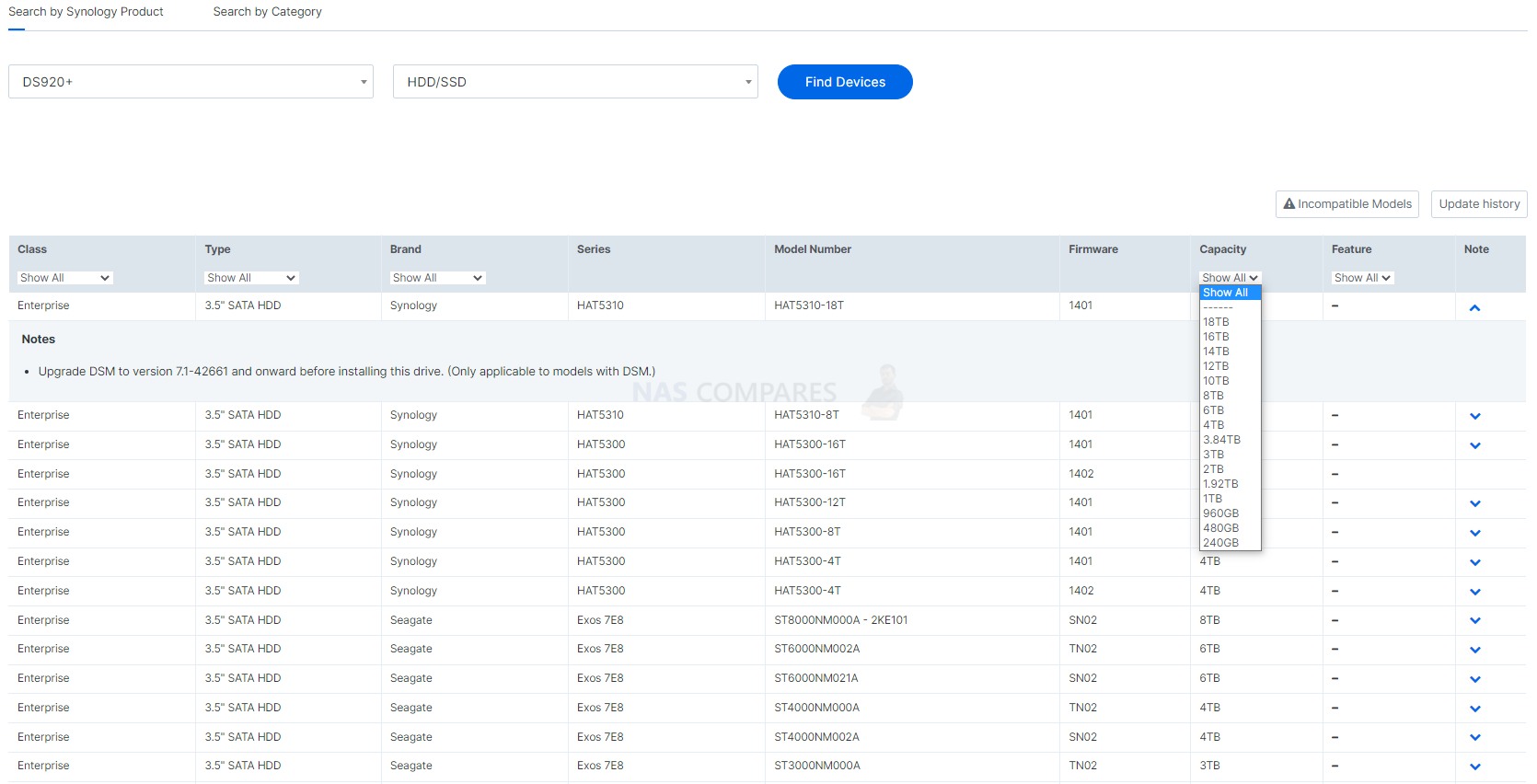
If you install an HDD or SSD inside a Synology system with the latest version of their software platform DSM, but the HDD in question is not on the compatibility list, you are greeted by a message that will detail that the drive is not recommended in the storage manager.
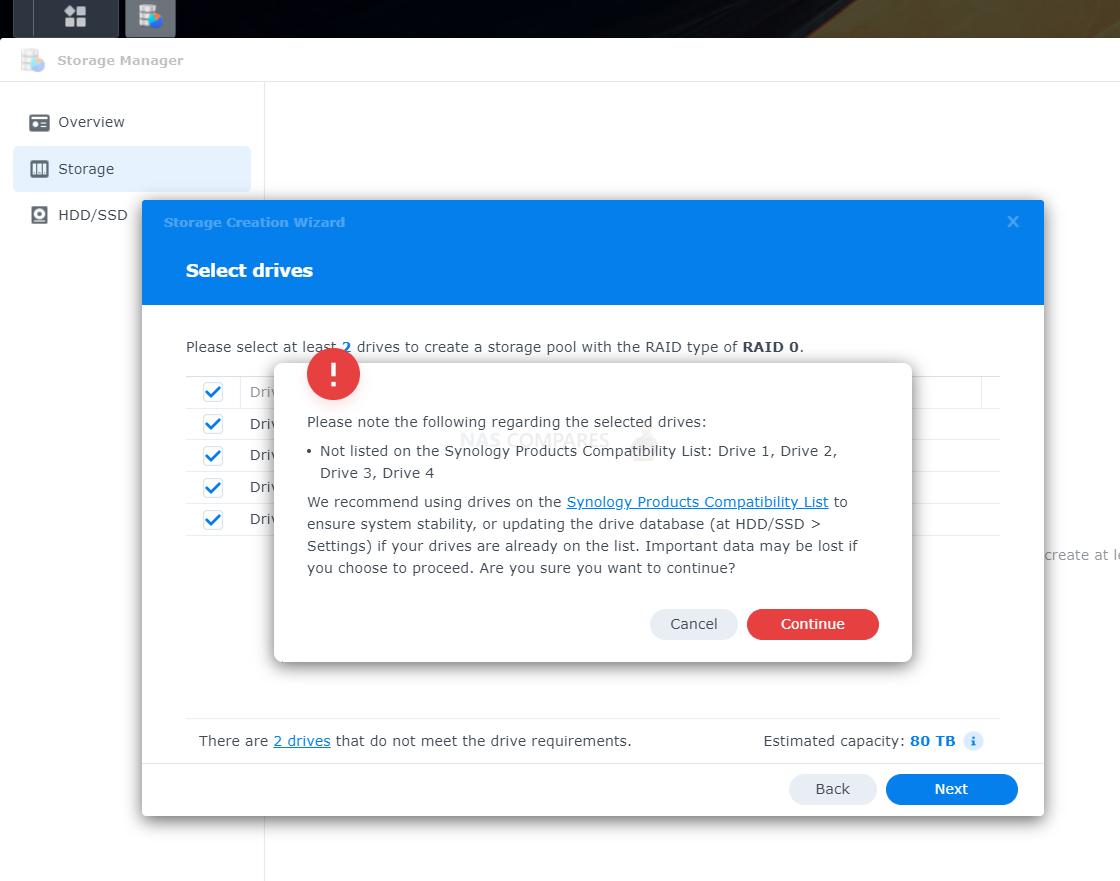
You can still use the HDD for Storage Pools, Volumes, Hot-spares, etc, but it is an oddly jarring message for some. Of course, this is the current compatibility of this HDD at the time of writing and may well change in the future as further HDD capacities arrive and additional compatibility testing takes place.
Nevertheless, you can still push through this warning and proceed to test the performance of the Seagate Ironwolf Pro 20TB HDD from within the Synology Storage Manager. Here was the results.
The HDD compatibility of the Seagate Ironwolf Pro 20TB Hard drive on the QNAP NAS platform is less complicated (eg the 18TB HDDs from most brands are listed) but at the time of writing the 20TB models are still not on the available list of compatible HDDs (again, this will likely be addressed shortly after commercial launch). Here is how the drive is benchmarked and appeared in the QNAP NAS system.
Noise Testing the Seagate Ironwolf Pro 20TB NAS Hard Drive

This is something that is often overlooked when users are getting excited about bigger and bigger HDDs entering the market and the Seagate Ironwolf Pro 20TB is no exception to this – NOISE! Because of the sheer scale of hardware that is getting packed into these larger capacity 3.5″ HDD casing and the more industrious hardware inside that needs to perform 24×7 durably, operational noise is unavoidable. Once you exceed around 8-10TB (HDD brand dependant), the increased platters and heavier duty actuator/arm mechanism needs to be a grat deal more reactive (due to the larger space that is needed to be covered ad-hoc. The Seagate ST2000NT001 20TB is a pretty spot-on example of this and although you are getting some great performance, it is achieved with a large amount of mechanical work under the bonnet. Now, if you are running a larger-scale data center/rackmount style setup, this is not going to be much of a barrier. As those kinds of server will have multiple fans and use horizontal pressure fan cooling – so they will be much louder than the drives! However, in more modest 4-8 Bay desktop NAS systems, its a different story, as these use smaller/quieter fans and alongside being more conductive of vibration, the noise of these drives in operation will be a great deal more obvious.
Here is an example of four Seagate Ironwolf Pro HDDs in a Synology DS923 4-Bay NAS, running an intense 4K IOPS benchmark on the drives (likely the LOUDEST THING you will ever hear, so this is not truly representative of idle/standby/low use):
And here is the same test being performed in a QNAP TS-464 NAS 4-Bay with Seagate Ironwolf Pro HDDs . Same 4K Benchmark scenario, in a similar scale 4x RAID 5 setup as the Synology. Again, this represents PEAK access. In a regular idle/standby, it will be quieter.
If you want a better idea of typical operational noise and noise when booting the drive with the Seagate Ironwolf Pro 20TBs, watch the middle portion of the YouTube review HERE. Regardless, if you are sensitive to noise, will be in close proximity to the NAS device (direct 10GbE editing?) and will be running a smaller scale NAS system – then these new 20TB HDDs might not be quite your cup of tea!
Seagate Ironwolf Pro 20TB Hard Drive Review – Conclusion
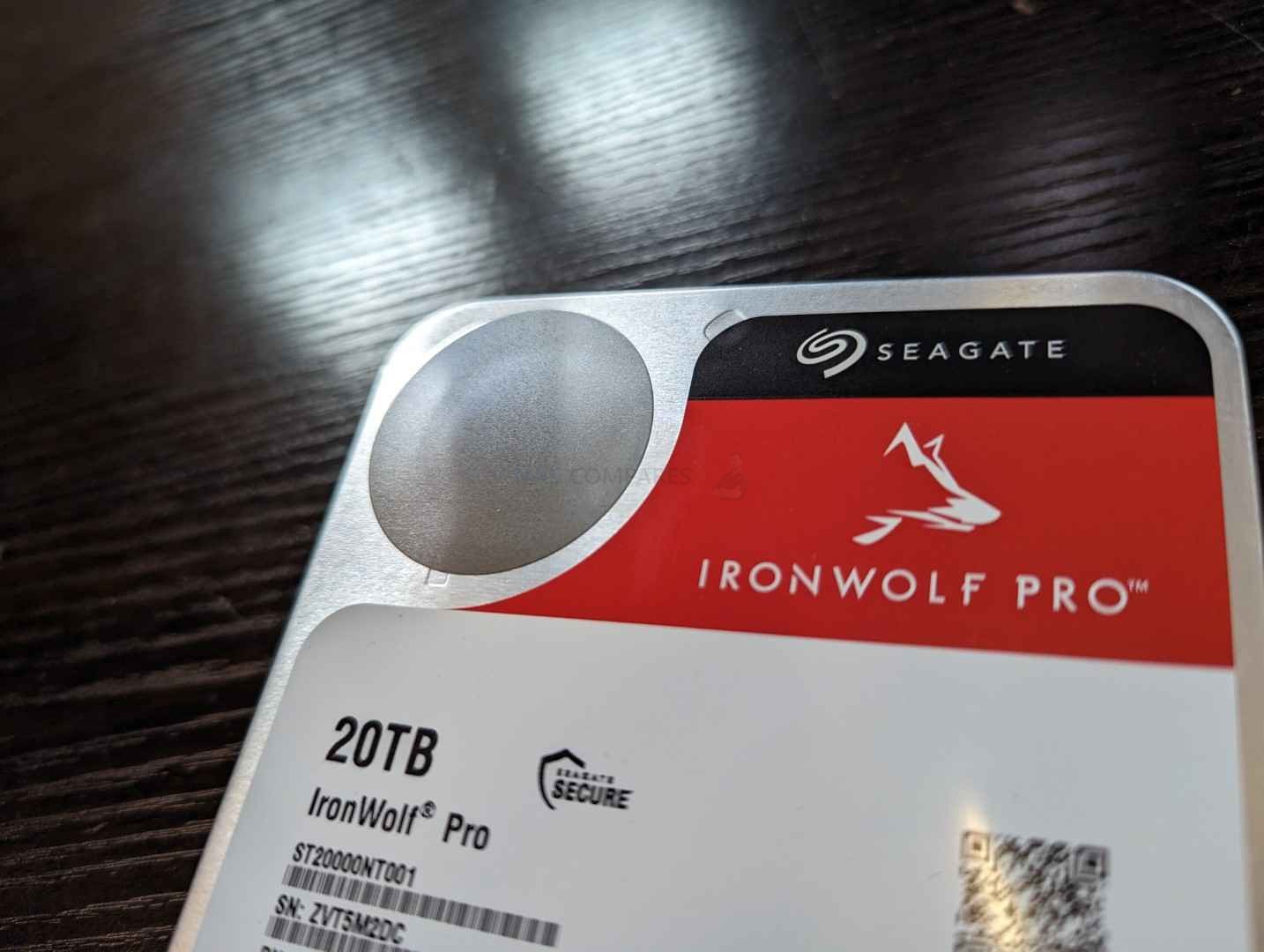
Straight out the gate, the Seagate Ironwolf Pro 20TB HDD comfortably delivers on it’s promises of performance. This alongside full tested and confirmed compatibility with Synology and QNAP NAS devices means that you have a drive here that can turn any 4-Bay NAS into a 60TB RAID5 Storage colossus – let alone once you start thinking about rackmounts and hyperscale. The pricing at the time of writing is a little muddled (the result of having two SKUs/Model IDs floating around in the market and eTailers having to play catch up) but that should hopefully iron out over time. I particularly appreciate that the workload discussion surrounding ‘Pro’ Class drives at 300TB/yr vs rapid HDD capacity growth is being addressed here with a 550TB/yr version to rival that of ‘Ent’ class drives – whatever the reason/motivation. The value of the Ironwolf Health Management tool is going to be something of debate and the inclusion of 3yrs data recovery services is a nice extra that (with any luck) few will need to use – but having them included in a 20TB HDD that still manages to maintain a similar level of Price per TB vs the bulk of NAS HDDs in the Pro tier increases the value notably. As HDDs continue to increase in scale and Seagate (among other brands) continues to outline their plans to hit 50TB by the end of the decade, the Seagate Ironwolf Pro ST2000NT001 is another good example of an HDD that finds a sweet spot between price, durability and value. Just be aware that this is a drive designed for large-scale use and that means high operational noise and higher than typical power use than non-Pro and smaller cap drives!
| PROs of the Seagate Ironwolf Pro 20TB | CONs of the Seagate Ironwolf Pro 20TB |
|
|
🔒 Join Inner Circle
Get an alert every time something gets added to this specific article!
This description contains links to Amazon. These links will take you to some of the products mentioned in today's content. As an Amazon Associate, I earn from qualifying purchases. Visit the NASCompares Deal Finder to find the best place to buy this device in your region, based on Service, Support and Reputation - Just Search for your NAS Drive in the Box Below
Need Advice on Data Storage from an Expert?
Finally, for free advice about your setup, just leave a message in the comments below here at NASCompares.com and we will get back to you. Need Help?
Where possible (and where appropriate) please provide as much information about your requirements, as then I can arrange the best answer and solution to your needs. Do not worry about your e-mail address being required, it will NOT be used in a mailing list and will NOT be used in any way other than to respond to your enquiry.
Need Help?
Where possible (and where appropriate) please provide as much information about your requirements, as then I can arrange the best answer and solution to your needs. Do not worry about your e-mail address being required, it will NOT be used in a mailing list and will NOT be used in any way other than to respond to your enquiry.

|
 |
Best NAS for under $499
Best NAS for Under $250 (2025)
Minisforum N5 Pro NAS - FIRST IMPRESSIONS
HexOS Q2 Update - What's Changed?
5 Exciting NAS Coming Later in 2025
Beelink ME Mini vs GMKtec G9 vs CWWK P6 NAS Comparison
Access content via Patreon or KO-FI


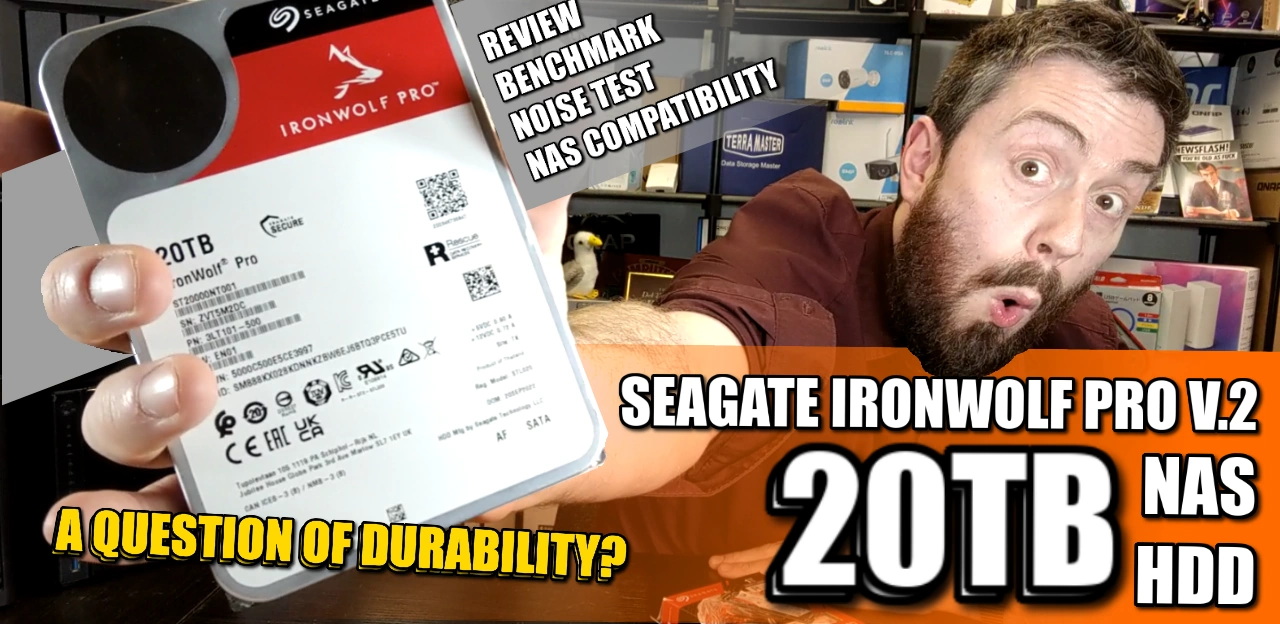
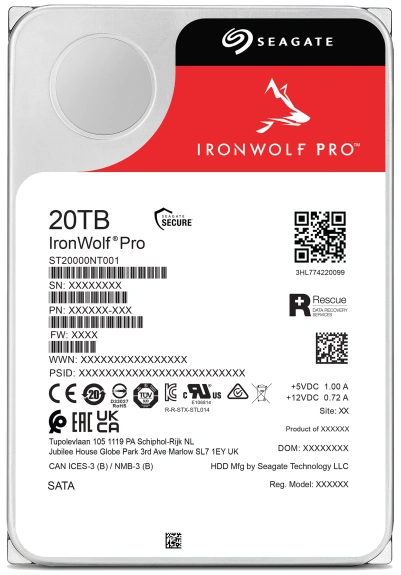
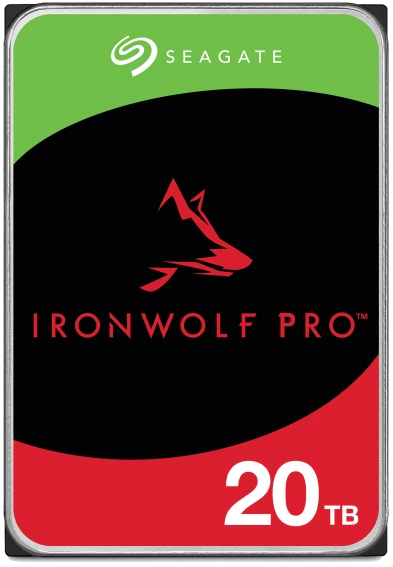
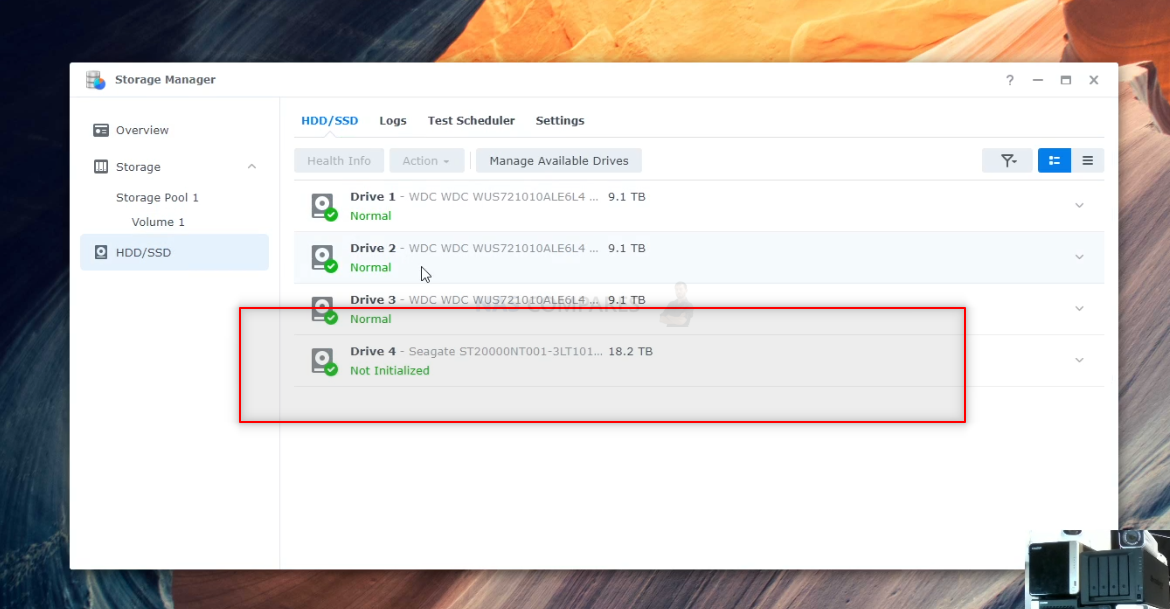
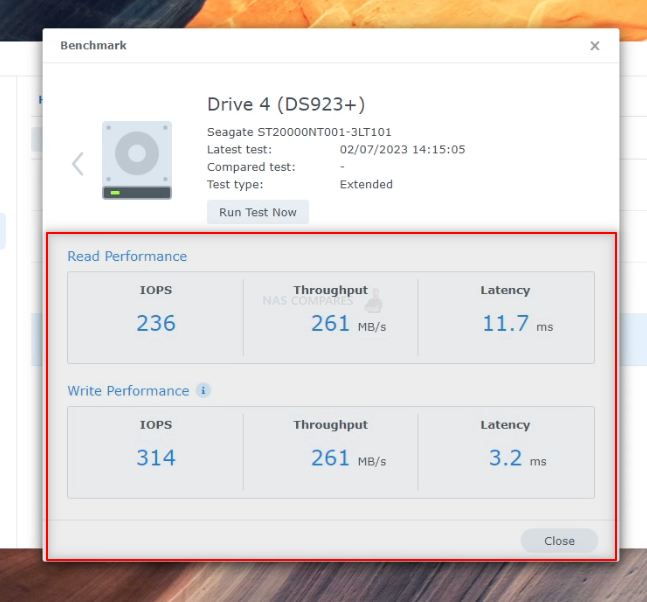
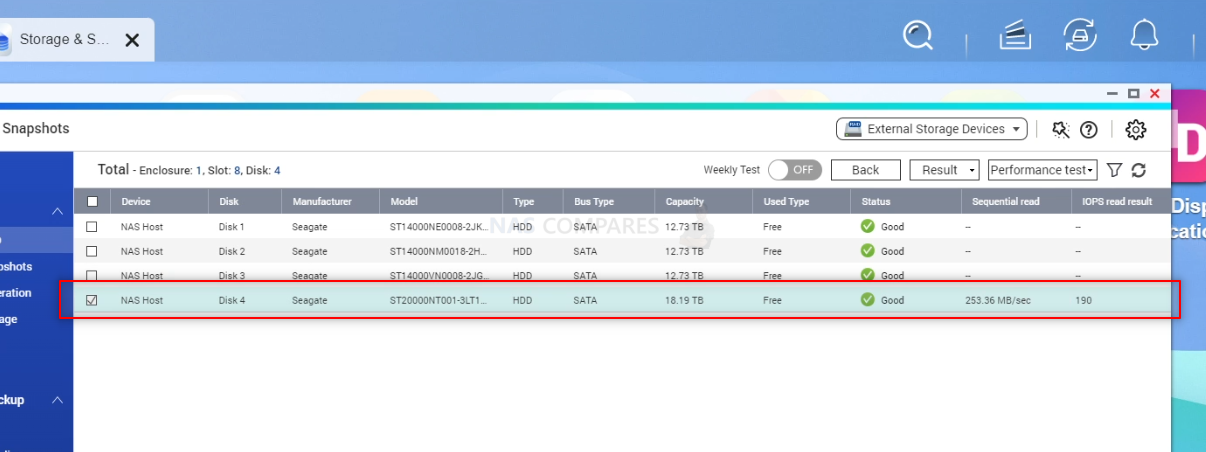
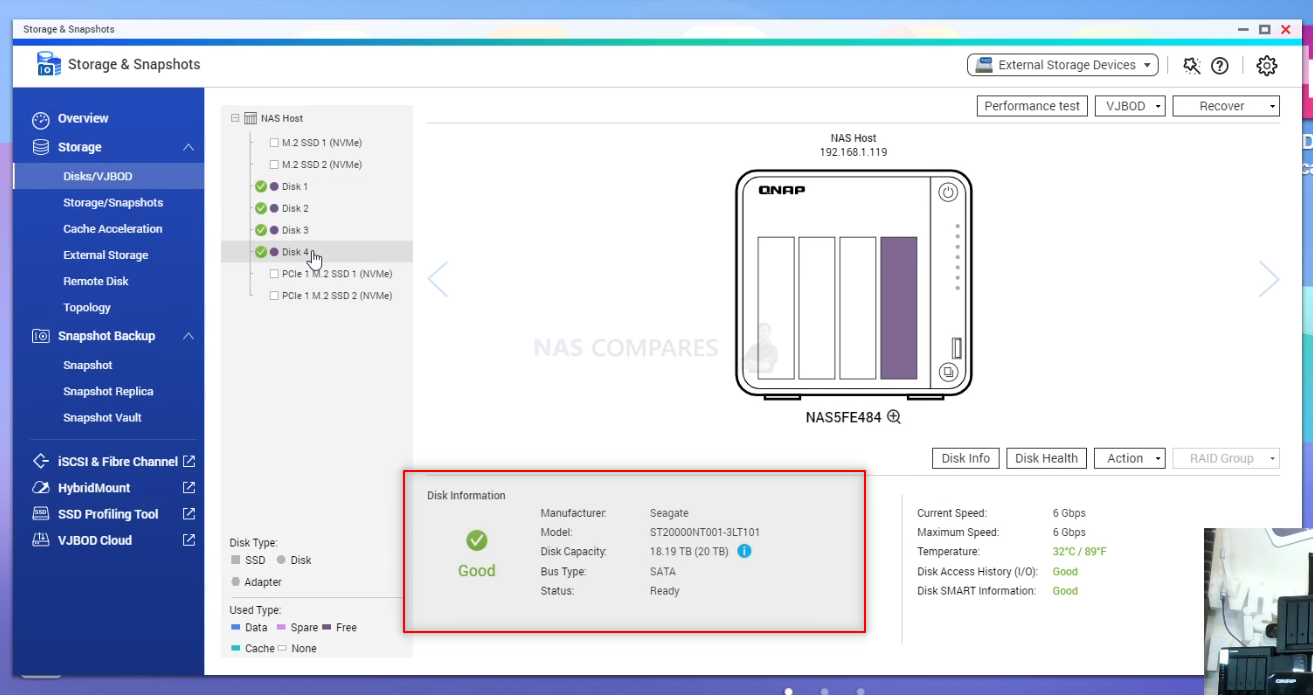




Apparently these are really loud but in my Define R5 case all sealed up I can barely hear the tower is on when I walk by it. Got 4 of them in there.
REPLY ON YOUTUBE
I am in the midst of this process and am sick to my stomach over the situation. I’m a retired pentioner. Have an old HP laptop. Not damaged just dead. took it to several places just to retrieve the documents. No luck. Finally sent it off to a big company and now i feel like a hostage. They have the drive. They say they can access it. Cannot provide me with a list of what is one it. Want 2500 American dollars just to rescue Word documents. Very discouraging. Cannot ever afford this.
REPLY ON YOUTUBE
One word of advice: go straight to the point, this video should be 10 minutes
REPLY ON YOUTUBE
I’m disappointed you didn’t mention this is a scam ~ this is an industry wide scam headed by one of the largest companies in this market, one of only a few manufacturers who own the market.
You pay a fee so they can fix your drive??? It shouldn’t be designed to break.
May as well use reputable Chinese drives like Adata and SP
REPLY ON YOUTUBE
Robert, nice video. Thou they will recover data from dynamic file-systems like ZFS, BTRFS, With RAID configurations?
REPLY ON YOUTUBE
Man, it really is true that British people have the worst teeth.
REPLY ON YOUTUBE
My experience has been less than expected. I recently purchased five IW 20 TB drives and three of them were defective. The OS could see the hardware but they were not readable. Looking at the lack of stock and the abundance of refurbished drives in the market suggests that Seagate has a production problem.
I think you may have misinterpreted their statement of “95% success rate”. I’d wager they mean: 95% of the time, we are successful in recovering the data. 5% of the time, we are unable to recover the data. Not, we average a 95% data amount recovered per drive. I think 95/100 we recover the drive. 5 times out of a hundred, we just can’t do it.
REPLY ON YOUTUBE
Thanks for the video @nascompares.
I used the +Rescue service once about 25 years ago, maybe longer and it worked well. The client got the data back and a replacement drive.
However, now I have the same issue (clicking drive) and I can’t even get them to issue a shipping label.
It’d be great if you could review this again and see what the change is for you.
REPLY ON YOUTUBE
Glad to watch this! Hopefully it helps me
my second seagate IronWolf drive has failed within a year, both were less than 1 year old.
Currently working out whether customs duty charges from Netherlands to Australia are worth it
REPLY ON YOUTUBE
ST4000NT001 have 2x2TB platters or 3x2TB platters short-stroke?
REPLY ON YOUTUBE
I’m thinking of buying a new laptop, any clue how to make sure you can fit one of these into it?
REPLY ON YOUTUBE
the new version of the disk is compatible with the synology? DS+ series, i can’t find them on the compatibility list
REPLY ON YOUTUBE
Have you tested this drive on a DS1520+? I want to put one of these on mine but would hate to spend the money just to find it doesn’t work
REPLY ON YOUTUBE
We don’t have this type of 20TB in our market I have ordered one from Amazon the question can be formatted using WINDOWS 10 version. Need a quick answer if possible from u
REPLY ON YOUTUBE
Will this work in ps4 pro?
REPLY ON YOUTUBE
“healium” sealed? Ill people will suck it out. Also “Iironwolf.” did it in a hurry? 🙂
REPLY ON YOUTUBE
Shame they haven’t able to reduce cost of HDD even in 20 years. Addinng more TB and rasing cost at the same time is pointless.
REPLY ON YOUTUBE
I always tell people to keep away from Seagate and if you do go with a back up system software to USB or cloud just in case
REPLY ON YOUTUBE
10:00 – I don’t like it when my hard disks made seagull noises! ????
REPLY ON YOUTUBE
I’ve been looking at a drive for my media files, I could spend £550+ for a ready-made portable drive, but this drive + an enclosure will be way cheaper…much appreciated.
REPLY ON YOUTUBE
8:45 Funny how the moving needle against a circular background on the dB meter pretty much looks like a visual representation of the disk’s actuator moving across the spinning platters.
Nice in depth review with lots of useful info. No matter how much I would love to have a raid array filled with 20TB drives, I don’t think I would pick the Ironwolf for the same reason as why I wouldn’t buy WD Red drives. That noise would drive me crazy. I use 10TB WD Gold enterprise drives for a a few years now and they are also pretty quick but running whisper quiet most of the time.
REPLY ON YOUTUBE
This fast talking Brit talked me into a NAS, and then 200,000 syllables later, talked me right out of it.
Does anyone know of a less frenetic source for simple NAS info? I want my Lightroom photos available, back up 5 iPhones, 2 iPads, 3 MacBook Pro’s, and maybe put my 1200 DVDs and 100 Blu-rays on the NAS to play in home only on AppleTV and iPad and iPhones. That’s it. I don’t need tons of apps or internet access to my NAS, just local.
REPLY ON YOUTUBE
really enjoy your videos on high end cmr HDDS! i use a ton of exos drives myself so many uses from nas to gaming apretiate the info! keep it up im hoping they keep innovating hdds as data is getting bigger and bigger especially for games. i have 40tb for data, games, and digital dvds.
REPLY ON YOUTUBE
Do these Hard drives make noise when you are writing on them and reading from them or just when writing? Thanks
REPLY ON YOUTUBE
Does anyone have any idea if there are any difference between these two different models of the Seagate Ironwolf Pro 20TB HDD available on Amazon?
ST20000NT001 (old?) vs. ST20000NTZ01 (new?)
Based on the information available, it appears that the ST20000NT001 and ST20000NTZ01 are the same Seagate Ironwolf Pro 20TB HDD model. The “NT” in the model number stands for “non-retail,” indicating that the drive is intended for use in a network-attached storage (NAS) system rather than being sold as a standalone retail product.
I’m a new subscriber and I recently watched this video and ended up buying one but my DS920+ will not recognize it. I called Synology support and they tell me that my unit doesn’t support 20tb, 18tb max is allowed. How did you get yours to work? Confused, thanks
REPLY ON YOUTUBE
Third time i use the rescue service. Not once has it been able to recover my data. It’s a pure marketing scam. Period.
My last drive just stopped functioning with 7 tb on it. No fall, no surge, nothing. And yet, they could not retrieve a single bit of data.
Well that’s not really surprising at all.
Do you know how much it costs to actually get your data back using pro service? For a 8TB like mine, no less than 2000 euros.
Do you honestly thing they would endorse that kind of service for a mere 100$ (price of the HD) including the returned refurbished HD? Seriously? Come on. It’s a marketing trick. No more.
REPLY ON YOUTUBE
I have the 10TB version is way more powerful than WD or Barracuda
REPLY ON YOUTUBE
I can not stop laughing at you getting angry with it still working and the banging off camera HAHAHAHA ???????? that drive took a hell of a beating, certainly a testimony to seagates durability love it great video bud ????
REPLY ON YOUTUBE
Don’t buy I am use these rescue data facilities they don’t recover my data
REPLY ON YOUTUBE
Ironwolf Pro & Exos drives are obnoxiously loud for a home setup unless you update the firmware and disable their EPC settings. Just make sure you do that before using them because it’s a real mess doing it after. That might be an idea for a video, testing to see the difference that makes to say, Exos X18 set of drives.
REPLY ON YOUTUBE
I can’t find the NT version ANYWHERE for purchase no matter how hard I look. How do you get this thing? All I can find is the ST
REPLY ON YOUTUBE
Thanks a lot for these reviews, especially regarding real life noise testing. However maybe I messed it, but a key element is also the actual size of these disks in terms of TB, currently I have 4 “12”TB drives in a 920 (WD red plus WD120EFBX), but Synology rates them at 10.9, not 12. How many do these rate on a synology ? (or other brand)
REPLY ON YOUTUBE
Could this be used for uploading 4k videos to YouTube after recording them via SSD or NVME?
REPLY ON YOUTUBE
Amazon are selling them for a bargain but have you seen the failure rate ? 28% That means Amazon employees are throwing them all over the place before their shipped out. If you don’t believe me then checkout the reviews.
REPLY ON YOUTUBE
Thanks for the video. Can you also tell me what would be the difference between the two models of WD Ultrastar – 20TB DC HC560 #0F38755 vs. #0F38785. I talked with WD – they did not share any information of what is new/changed/fixed… Hope you can help!
REPLY ON YOUTUBE
can i buy a ds220+ and put this ironwolf 20tb into in it and use it?
REPLY ON YOUTUBE
We tend to stay away from high-capacity drives as a) they do generate a lot more heat b) are indeed a bit nosier c) when they do fail, the shear amount of data on the failed drive (size) takes considerable time to rebuild again. (sometimes several days).
If you have a few drives, 20TB might be tempting to have a very decent amount of storage but I rather have smaller HDD’s (8, 10, 12TB maybe 14TB) spread over more NAS-ses if more capacity is needed.
And if I calculate the price per TB, I believe this HD is more for the professionals whom do not care that much about the prices..
So, sorry but I have to pass.
REPLY ON YOUTUBE
Fantastic work!
REPLY ON YOUTUBE
is it just me or has the audio and video been out of sync in the last few videos
REPLY ON YOUTUBE
I only buy EXOS drives the last 2 yrs, they are cheaper and i think better than the NAS series drives.
REPLY ON YOUTUBE
I bought 3 x Ironwolf 16TB ST16000VN001 as part of the Boxing Day sales. Of the 3, two had the traditional branding and the 3rd had exactly the same new branding as what you have shown. For the newly branded drive, all I can say is what an absolutely TERRIBLE drive … it’s noisy as hell and the “clunking” just drives you insane. Returned it and the replacement was exactly the same. Note the other two drives with the old branding are whisper quiet. Don’t know what Seagate have done but it has certainly now put me off buying any more of their drives.
REPLY ON YOUTUBE
Sqaw Sqaw Sqaw! Yay Seagulls!
REPLY ON YOUTUBE
Will selfish Synology play nice and recognize the drive? We all know how Synology is clamping down on non synology drives. I know you mention it, but would like to see it tested.????????????
REPLY ON YOUTUBE
Seagate and seagulls, what a combination. 10:05 ????
Excellent video, thanks for the information.
REPLY ON YOUTUBE
Seagulls at 10:30! Was hoping to hear some.
REPLY ON YOUTUBE
Love your work but really, as a foreigner, your accent is so strong that i cant focus at all lol. Seems like you are talking with 1l of water in the mouth
REPLY ON YOUTUBE
Hoping 18TB drives get cheaper
REPLY ON YOUTUBE
I bought the 16TB Iron Wolf Pro. Dead in 2 months. Seagate warranty is so hard to deal with too.
REPLY ON YOUTUBE
Thank you and is the seagull noise filter option running? ????
REPLY ON YOUTUBE
Thanks for all the knowledge you share on your channel! I built my first NAS last summer, and could not have done it without your guidance and advice. I’ll keep following you for updates, upgrades, and other interesting information.
REPLY ON YOUTUBE
It really sounds like an awesome service, but what about availability? Because I was not able to find what countries it is covering. If anybody has a link, please reply.
REPLY ON YOUTUBE
I just put all of my docs and photos on a 4 tb drive and went to get the rest of the photos off of my phone and onto it and it won’t mount suddenly. so stressed out. your video is giving me hope because I did purchase the rescue edition with data recovery services. fingers crossed ????
REPLY ON YOUTUBE
I had a HDD external 14 TB Seagate with the data recovery. Warning to all. It failed and Seagate was not able to recover the data and has not replaced the drive as they stated they would do. I will never buy a Seagate drive again.
REPLY ON YOUTUBE
I would love to see a new comparison video between Seagates Exos and Ironwolf Pro Drives, because the new Ironwolf Pro generation (e.x ST8000(NT)001 / 500TB per Year Workload, 2M MTBF and unlimited drive bays supported) rivals the Exos Drives in my opinion.
I would like to hear your thoughts about it. Are those Exos Drives still a good Choice or are the differences between them irrelevant now? The Data recovery is a nice + for those Pro Drives
REPLY ON YOUTUBE
I would like to know if the DS920+ will support this 20to hdd ?
What is the maximum of storage i can have ?
REPLY ON YOUTUBE
What if you have a 16 tb drive that failed how is that recovered? how long would it take to download 16tbs of data? i have done gigs never TB’s. Excellent teacher. I learned a lot.
REPLY ON YOUTUBE
I am very glad to see the Write endurance increase on the larger Ironwolf Pro drives.
That opens significantly more use cases where I would recommend them.
If your NAS does monthly RAID scrubs, that alone can involve a lot of reading when the drives are large. So this is a very welcome change.
REPLY ON YOUTUBE
I recently shopped for a USB cable that would achieve 20 or 40 gbps, only to discover most USB-A to USB-C only provide more power (for faster battery charge) and only provide USB 2.0 transfer speeds. I did find a cable that transferred 300 MB/sec between an internal SSD and a Samsung T7 external SSD. It’s a usb-c to usb-c cable.
REPLY ON YOUTUBE
Can vouch for seagate took my 5tb 2.5 inch external drive that failed took 1 month they paid for all postage and I got it back with 95% data back on a free 4tb drive and a new one back that I’m now using lol. It’s fucking awesome I won’t buy any other drives while they offer this
REPLY ON YOUTUBE
Whenever is SATA going to be faster?
REPLY ON YOUTUBE
How about you put an Object All and Reject All on your website? Your cookie list and vendor list is a nuisance.
REPLY ON YOUTUBE
excellent
REPLY ON YOUTUBE
This is quite a good analysis of the service, thank you! It’s good to know that you can buy it retroactively if it wasn’t a part of the initial purchases of the drives. I have a whole bunch of Ironwolf drives I am considering it for.
REPLY ON YOUTUBE
11:37 psychopathy begins ????????????????????????
REPLY ON YOUTUBE
I’ve been seriously considering getting into data recovery. I’m just not sure how to find customers who aren’t friends who want it done for free lol
REPLY ON YOUTUBE
Keep up the amazing videos and content my man! I ended up buying a Synology NAS for the first time ever based on your videos! I’ve still yet to set it up so I’ll be checking out your video for that.
Thanks again for everything you’ve done; it’s lovely to see someone talk about their passions with such enthusiasm 🙂
REPLY ON YOUTUBE
Con #5 and the reason I never buy extended warranties: Even if I could benefit from one, I’m more than likely to forget I have it, or be too impatient to wait for it, or not care enough to go through the hassle. I don’t like to put myself in a position where I’m dependent on a company to honour their terms when they’ve already got my money and every incentive to find a loophole.
REPLY ON YOUTUBE
That 95% success rate might also be aggregated across all their customers. So, 95% of their customers get their data back, while 5% get nothing. My guess is it’s a combination of all the things you mentioned and the above.
REPLY ON YOUTUBE
Interesting. They say it is not suitable for a normal computer, but I see that it is included in one. Is a NAS hard drive really a bad choice for a desktop computer? I chose one only because I did not find another hard drive that uses CMR recording technique in my country that is 4TB. Everyone else uses SMR recording technique.
REPLY ON YOUTUBE
Its build for WAR.Its WAR resistand.
REPLY ON YOUTUBE
Stupid test methods. Even trowing the disk and putting in the water is not enough. You need to remove the disk while writing data on it.
REPLY ON YOUTUBE
I love this video ????
REPLY ON YOUTUBE